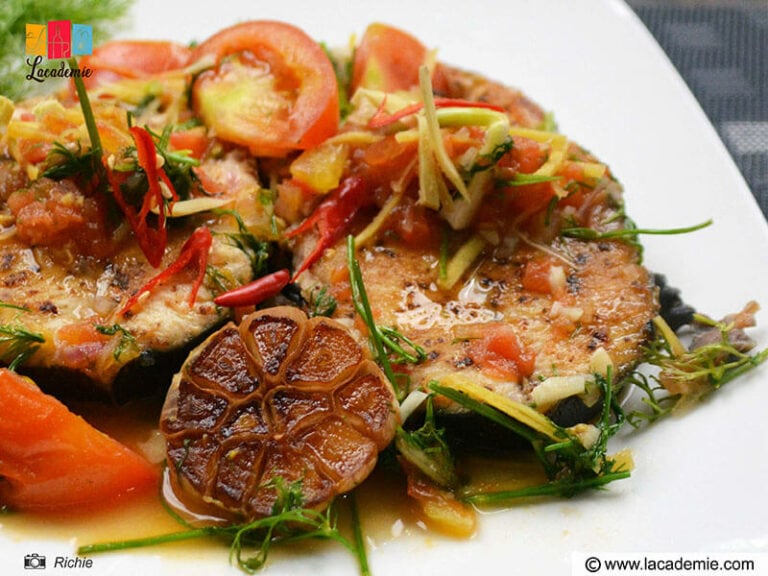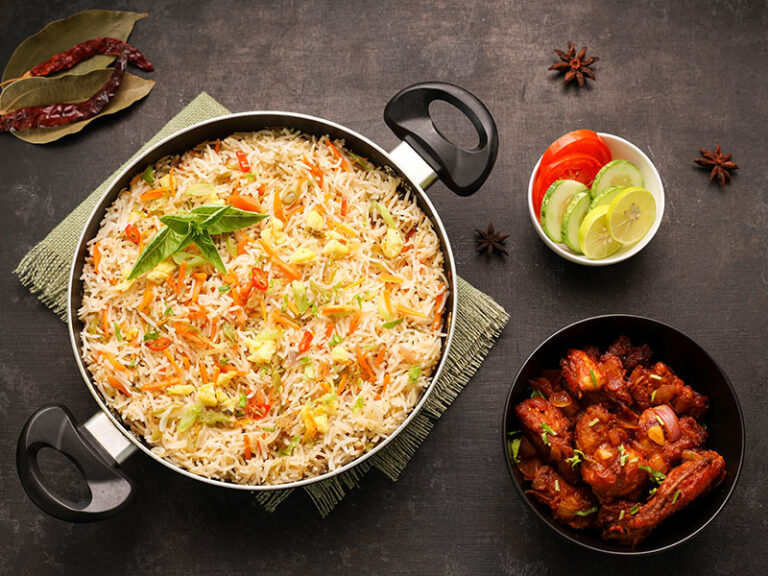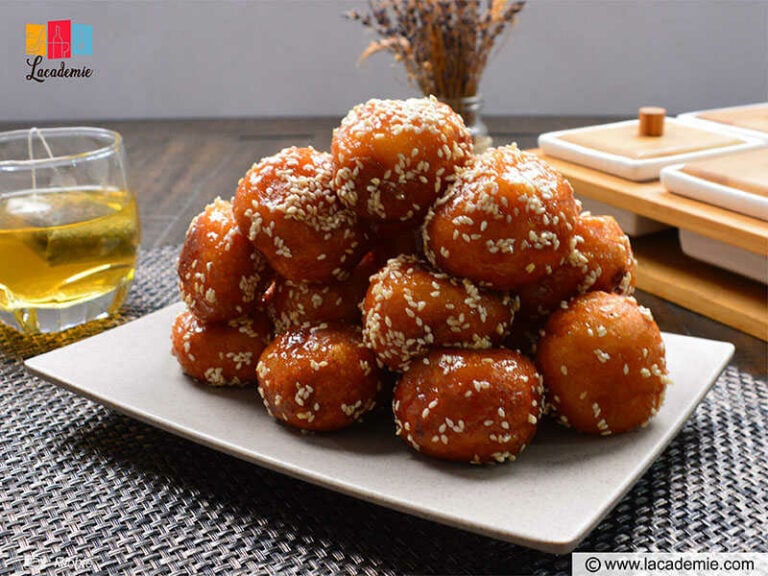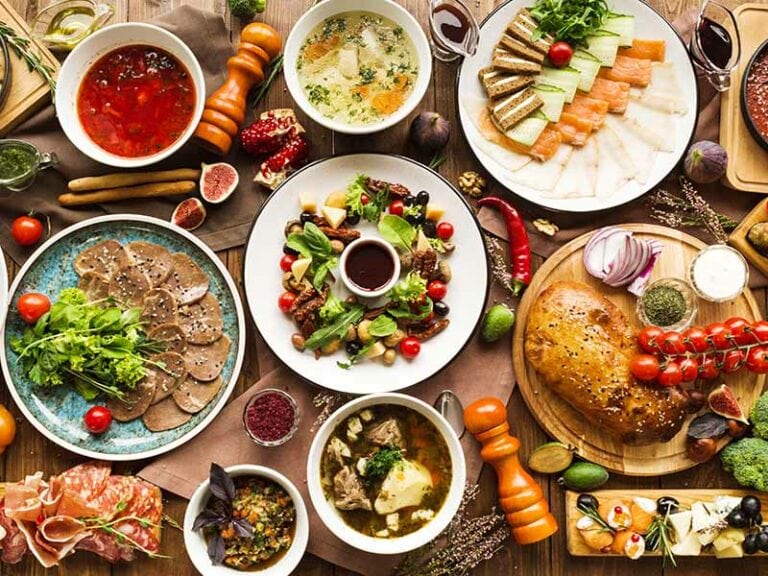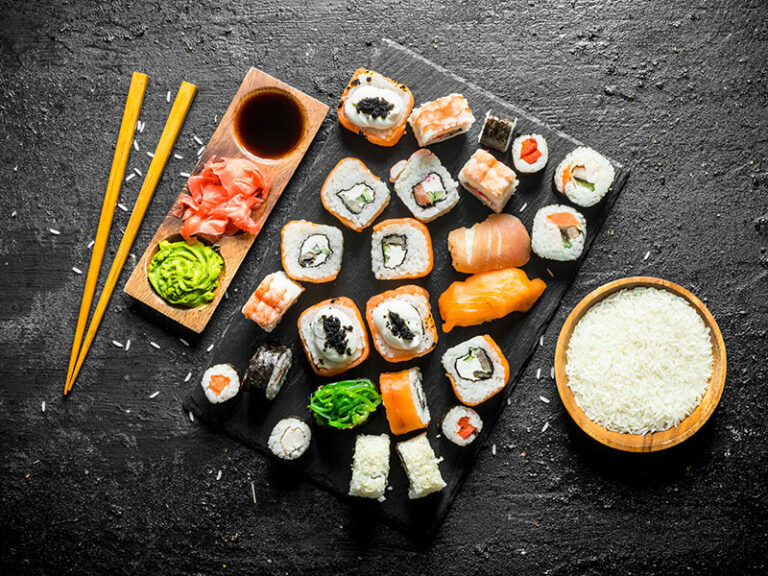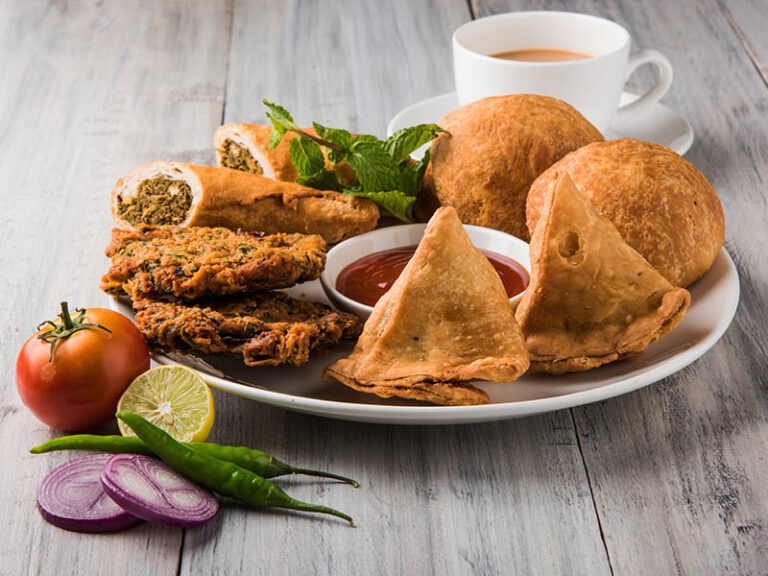Bustling streets, sizzling grills, and enchanting aromas; this is the vibrant world of Middle Eastern street foods. With so many tempting choices, it is easy to get confused about what to try first. But this article will guide you through the best dishes Middle Eastern streets have to offer.
Some can be easily found in Western food stalls, but others can only be experienced here. You’ll learn about the rich history of these dishes and gain insight into the unique flavors and ingredients that make them irresistible. So read on: this gastronomical treasure trove is for you!
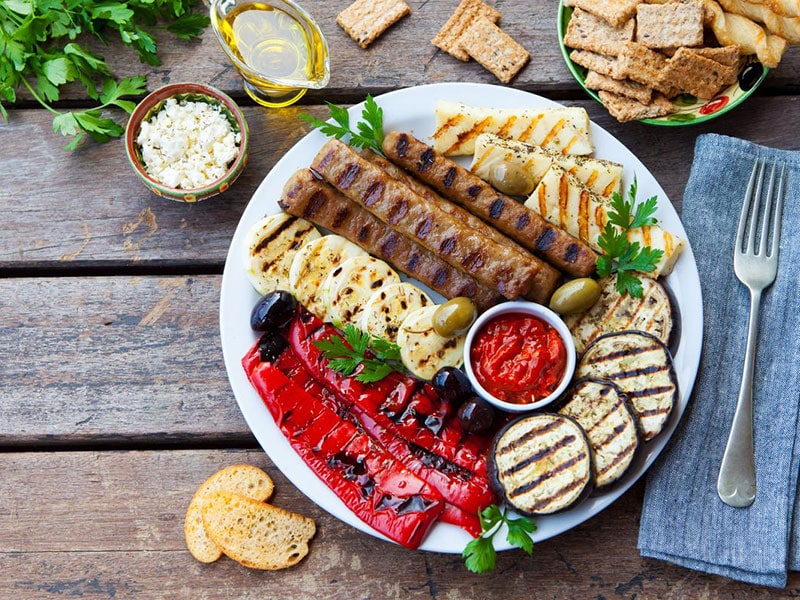
Brief Overview of Middle Eastern Cuisine
Middle Eastern cuisine is renowned for its rich, diverse flavors, colorful presentations, and the use of various spices and herbs. It spans a vast geographical area ranging from Morocco in the West to Iran in the East.
While many delicious dishes in Middle Eastern cuisine are deeply rooted in the nomadic and agrarian traditions of the region, trade and conquests also played an important role in their formation.
Due to the strong ties between the Mediterranean and the Middle East (many countries lie in both regions), many commonly used food ingredients in Mediterranean cooking appear in Middle Eastern street foods as well.
Key ingredients typically include lamb, chickpeas, eggplant, dates, mint, parsley, and a variety of spices such as cumin, coriander, and saffron. Bread is a staple, with countless regional variations.
Importance and Uniqueness of Street Foods in Middle Eastern Culture
Street foods are a vehicle for socializing, enlivening festivals, and showing hospitality. Locals love to savor them alongside popular Middle Eastern drinks, like tea or coffee, and chat with one another. They’re typically simple, affordable, and packed full of flavors, giving them widespread appeal.
The History and Influence of Middle Eastern Street Foods
Origins of Street Food in the Middle East
The tradition of street food in the Middle East is deeply intertwined with the region’s history. As trade routes developed across the Middle East, traders and travelers needed nourishing food that could be prepared and eaten quickly.
This gave rise to the tradition of street food vendors who would set up stalls in busy marketplaces. Over time, as cities grew, these vendors became an integral part of urban life.
Influences on and from Other Cuisines
The Middle East’s position as a crossroads of civilizations meant that its foods, including street food, were influenced by various interesting cuisines.
The Mediterranean, Central Asia, and the Indian subcontinent arguably had the strongest effects, such as the use of rice and spices introduced by traders from the East. Likewise, many prominent Middle Eastern vegetables and fruits have their roots in Asia.
Conversely, Middle Eastern cuisine has also significantly influenced other culinary traditions. For example, the use of certain spices, the method of roasting meat on skewers, and the concept of small, shared dishes (mezze) have all spread to various parts of the world.
Street Foods Shared By Various Middle Eastern Countries
Kebab
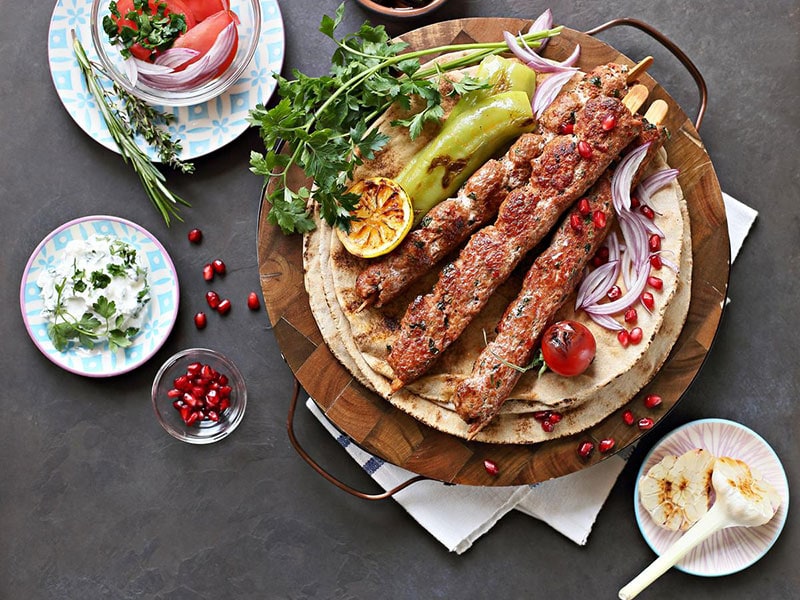
Kebab (also spelled as kebap or kabob) became an all-time favorite during my travels through Middle Eastern countries. For the uninitiated, kebabs encompass a universe of grilled and generally skewered meats, from lamb and beef to chicken and even fish. Pork is rare due to religious considerations.
While kebabs are available in many countries, the sheer diversity of Turkish offerings blew me away. There’s the Adana Kebab, long, luscious kebabs made of meat that melts in your mouth. Beyti Kebab, which is ground lamb or beef served in lavash bread, is another palate pleaser.
However, the crown jewel is arguably the Doner Kebab. It features thinly sliced lamb, beef, or chicken that is roasted on a rotating spit and shaved off to stuff into pita bread.
You should also taste Kofta Kebab, a rich creation of ground beef and lamb. Iran has a similar version called Kabab Koobideh.
Kebabs aren’t limited to Middle Eastern cuisine, though. For example, Chuan is a wildly popular grilled meat dish in China, a precious gem of Chinese Islamic cuisine.
Knafeh (Middle Eastern Sweet Cheese Dessert)
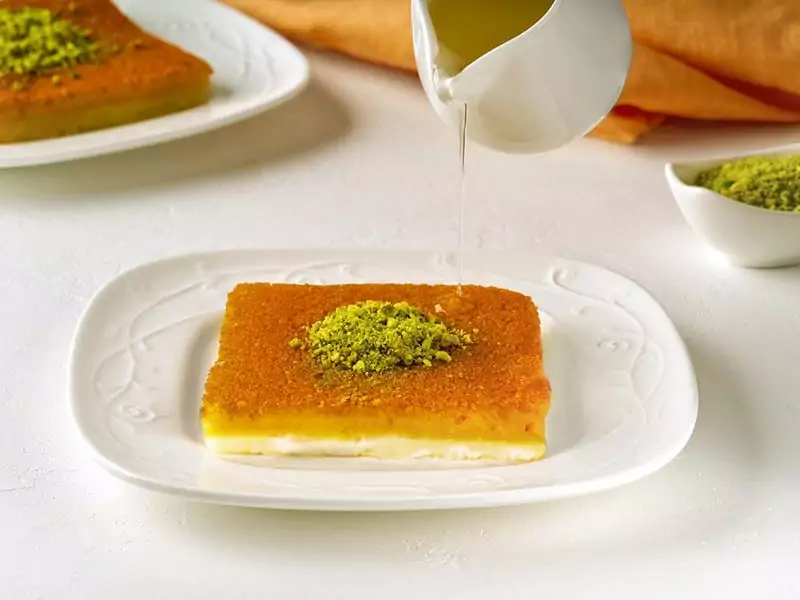
Tracing its roots to the Fatimid dynasty, Knafeh is an emblematic dessert in Middle Eastern cuisine, particularly in Turkey, Iran, and Palestine. Each region leaves its unique imprint on this dessert. One example is Palestine’s Knafeh Nabulsieh.
Knafeh consists of a shredded filo dough crust, which embraces a sweet cheese filling. A touch of simple syrup, subtly enhanced with rose water, adds a gentle sweetness. And then comes the finishing stroke, a sprinkle of crushed pistachios.
When serving Knafeh, it’s cut into slices, with the leftover syrup on the side. And here’s a little tip: try to savor Knafeh on the day they are made when the cheese is still warm and gooey.
Pita (Flatbread)
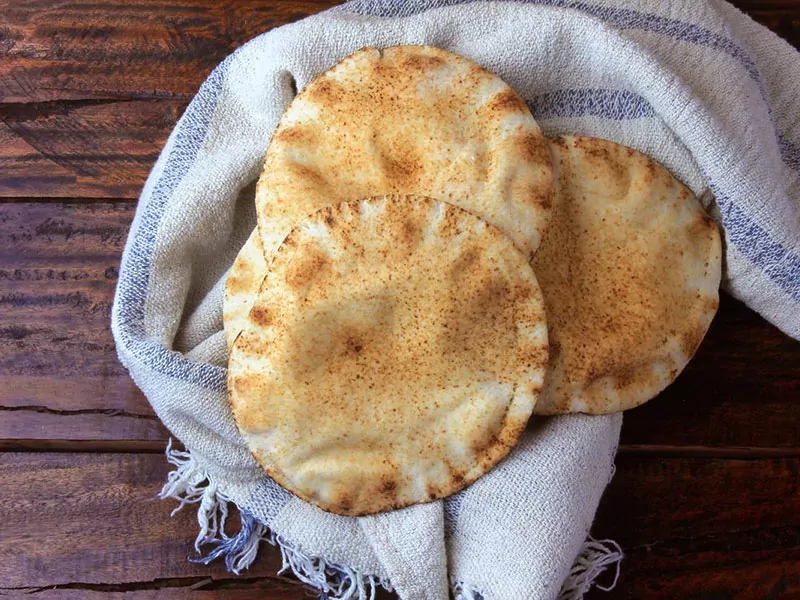
Also known as Arabic bread, pita holds the title of being among the oldest types of bread with its impressive 4,000-year legacy. Mainly found in Middle Eastern and Mediterranean countries, it is derived from a simple blend of wheat flour, water, yeast, and salt.
A distinguishing attribute of pita is the pocket that forms after baking, a hollow that becomes home to various fillings. However, the Greek pita doesn’t share this trait, hence its alternative name: pocketless pita.
Pita is very versatile in terms of culinary applications. It’s a go-to bread for wrapping kebabs, falafel, and gyros, ensuring a neat, hand-held meal. The bread can also double up as a makeshift spoon for scooping up dips and sauces (like hummus).
Pilaf (Mixed Rice Dish)
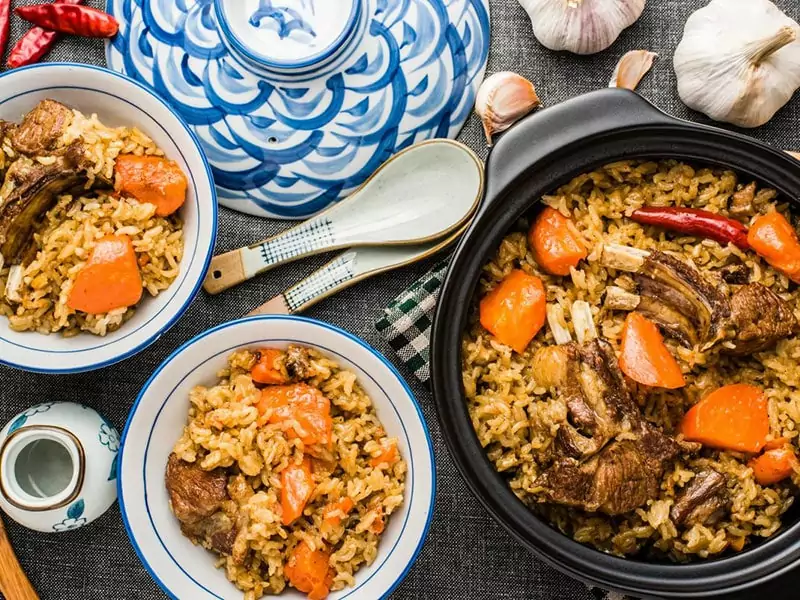
In the world of rice-based dishes, pilaf holds a special place. It’s an inviting combination of rice cooked in a hearty stock or broth, accompanied by meat, vegetables, and a medley of spices.
This dish isn’t limited to one corner of the globe. Central and South Asia, Eastern Europe, the Balkans, and, of course, the Middle East all have their unique pilaf recipes. There are countless Pilaf versions out there.
In some countries, you might find it served as street food, while in others, it graces the menus of high-end restaurants. For example, Nohutlu pilav is a classic Turkish street food with chickpeas and rice.
But don’t mistake pilaf for risotto. While they might seem similar, risotto’s creamy consistency is a stark contrast to the relatively dry texture of pilaf.
Falafel (Deep-Fried Chickpea Balls)
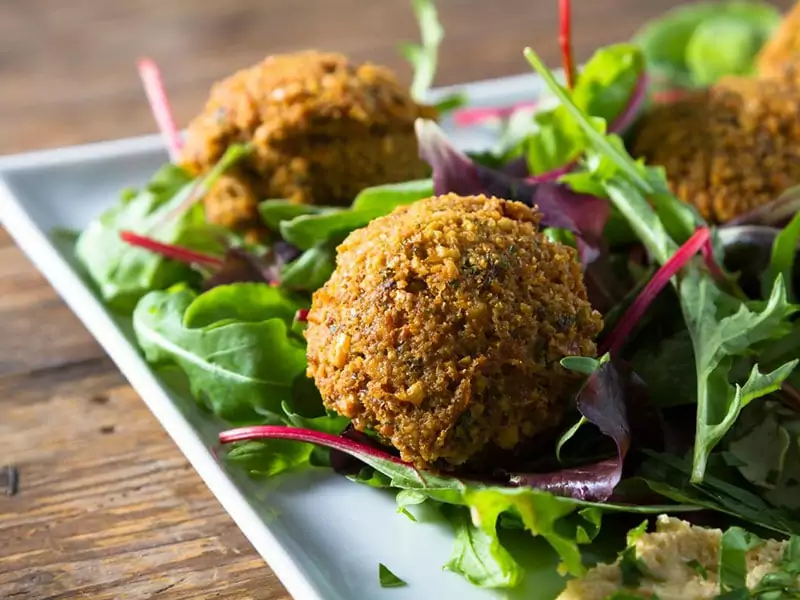
Falafels are one of the most famous Middle Eastern snacks. They are widely available at vendors or fast-casual spots in Turkey, Lebanon, Israel, Syria, and Egypt. But since this dish is fairly popular in many Western countries nowadays, you don’t have to travel far to taste it.
While this dish consists of ground chickpeas (or a mixture of chickpeas and fava beans), the magic begins when you add herbs and spices. This mixture is shaped into balls or patties, which get a deep-fried makeover in hot oil.
The result is a wholesome, protein-rich meat alternative vegans and vegetarians will love. It is very popular during Ramadan when fasting is required. If you plan on making falafel at home, soak the chickpeas well in advance.
Serve it hot, and you’re in for a treat! The ideal sauce pairings? Tahini (a sesame paste) or Tzatziki sauce work like a charm. But if you want to make it more filling, stuff the falafel inside freshly-baked pita bread for a healthy wrap.
Shawarma (Roasted Meat On Spit)
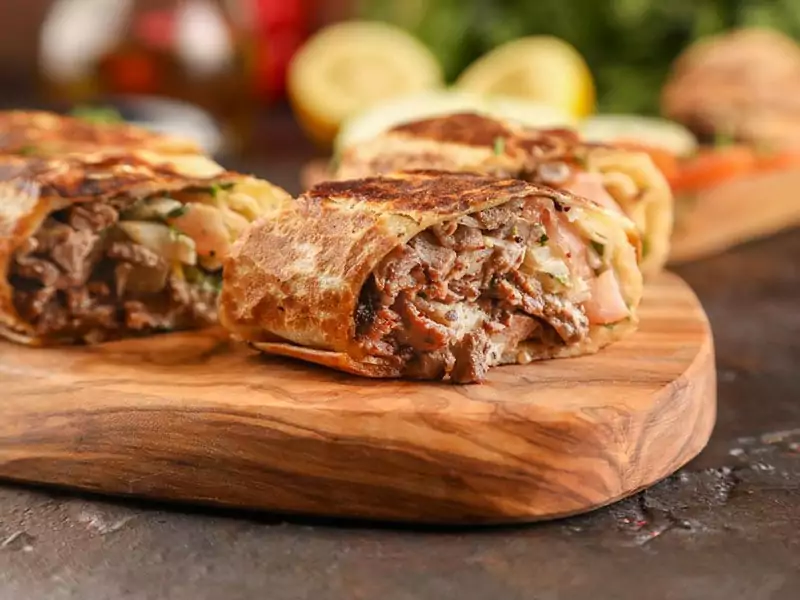
Shawarma first saw the light of day in the Ottoman Empire. Today, it is a favorite street food in Lebanon, Egypt, Syria, Palestine, Israel, Turkey, and beyond. Each region adds its unique twist to the recipe and presentation.
But the basic recipe of shawarma always includes thinly sliced cuts of meat (like chicken, beef, or lamb). The preparation involves marinating the meat for several hours before slowly roasting it on a vertical rotisserie or spit. The meat is then shaved off the be stuffed into a pita or flatbread.
Yes, that sounds similar to Greek gyros or Turkish doner kebab. They’re all delightful variations on the same theme. Accompaniments for Shawarma include tahini (sesame paste), garlic sauce, salads, or rice.
Shish Kebabs (Skewered And Grilled Meat Cubes)
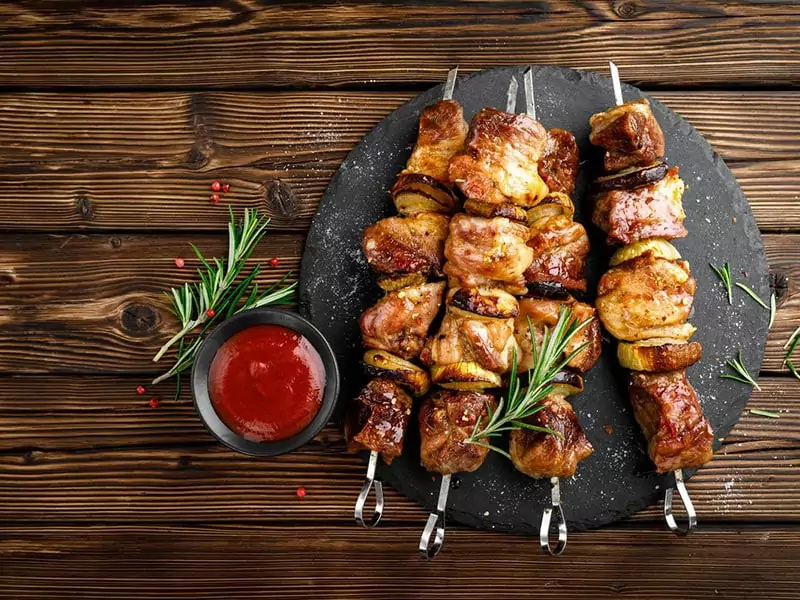
“Shish Kebab” came from the Turkish words “şiş” for “skewer” and “kebap.” This roasted meat dish is a stalwart of Middle Eastern street foods.
Here’s how it works: take pieces of marinated meat, often chicken, beef, or lamb, and perhaps some vegetables (like peppers, onions, and tomatoes). Douse the meat in a rich marinade of spices, yogurt, and lemon juice. Finally, skewer everything onto a stick and grill away!
The smoky and savory goodness will make your mouth water. I know this because it gets to me every time! Serve Shish Kebabs with rice, salads, and dips (like hummus or tahini) for a complete Middle Eastern experience.
Fattoush (Levantine Bread Salad)
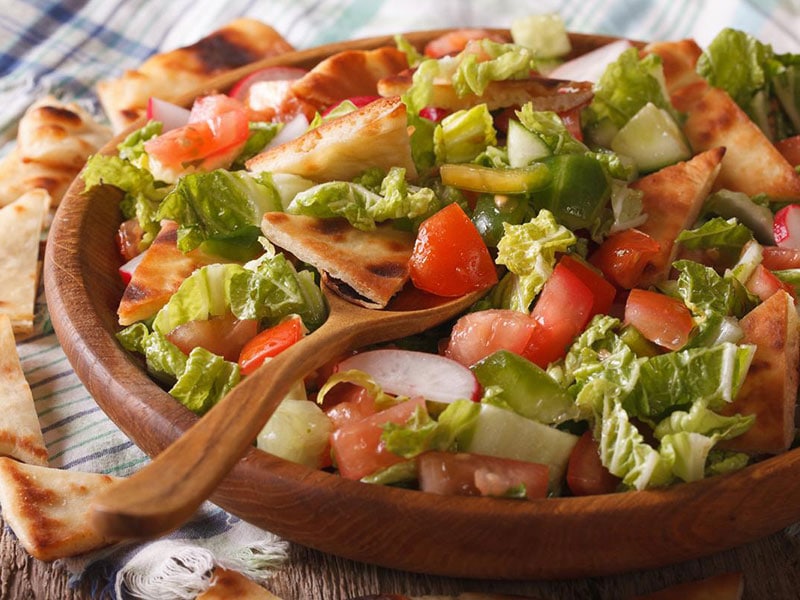
Fattoush is a refreshing salad from the Levant, which includes Lebanon, Syria, Jordan, Iraq, Israel, and Palestine. It’s what you’d call a “bread salad,” a melange of fried khubz (Arabic flatbread) and vegetables.
The common vegetables in a Fattoush include tomatoes, radishes, cucumbers, onions, and lettuce, among others. This refreshing dish can be easily found across the Middle East, but Lebanon is the most famous country for it.
If you think Fattoush and Tabbouleh are the same, hold that thought. While both of them are salads, the veggies in Tabbouleh are cut more finely. Tabbouleh also contains different ingredients, like cracked barley and parsley.
Grilled Halloumi
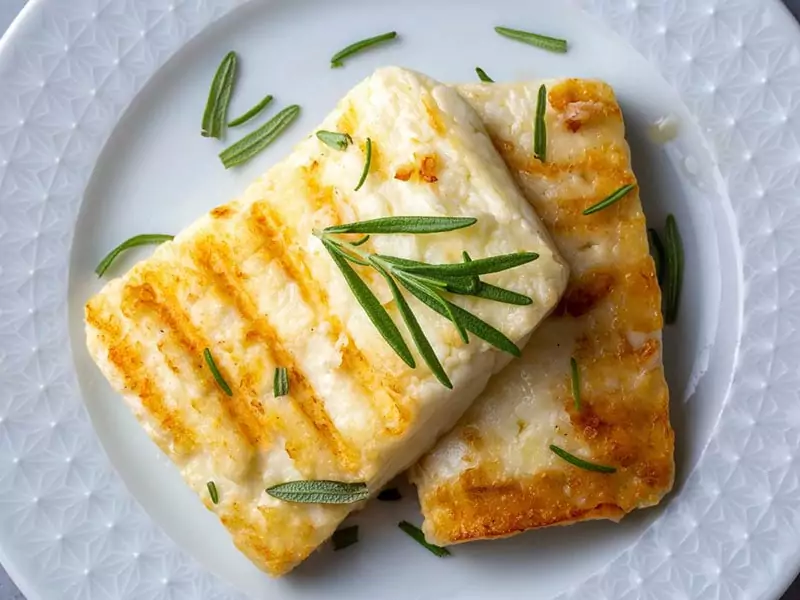
Halloumi is a Cypriot cheese made of goat and sheep’s milk. It is known for its firm texture and can be grilled or fried without melting, making grilled Halloumi a very interesting dish. Preparation for it is swift and straightforward.
All you need to do is grill each side of the cheese for 2 to 3 minutes. You’ll know it’s ready when you see a beautiful golden brown color and grill marks proudly stamped across the cheese. Pair it with slices of cucumber, tomatoes, and a sprinkle of Za’atar spice blend, and you’re golden.
Dolma (Stuffed Vegetables/ Vegetable Leaves)
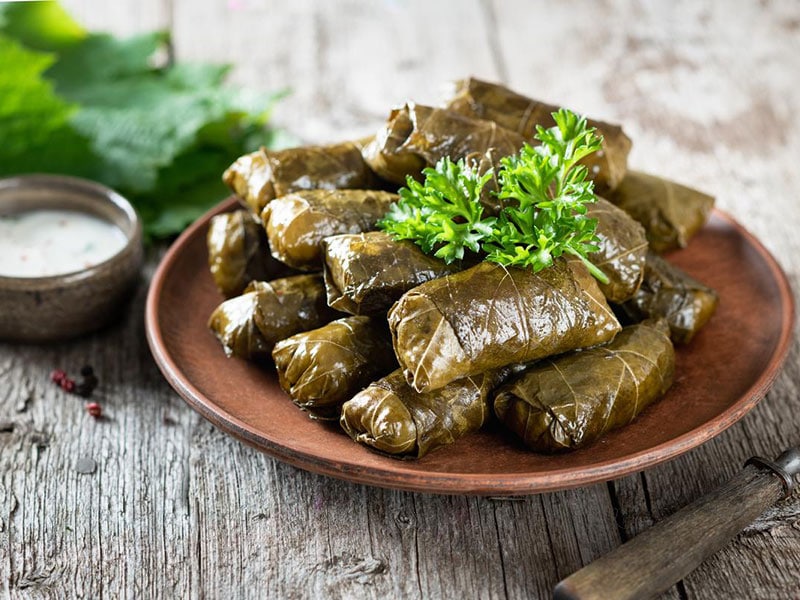
Dolma is the crown jewel of Ottoman cuisine. Its name is a Turkish word meaning “stuffed.” It usually involves vegetables (like bell peppers or zucchinis) or leaf wraps (like cabbage or grape leaves) filled with other ingredients. These can be rice, minced meat, offal, seafood, or even fruits.
The leaf wrap version is actually a separate category called Sarma, but many people still refer to it as Dolma. Anyway, this Turkish specialty is a common sight at street food carts and traditional mezze platters.
Among the many Dolma variants, I am most impressed with Midye Dolma sold in Turkey’s coastal cities. It is a combo of rice and mussels.
Baklava (Layered Pastry Dessert)
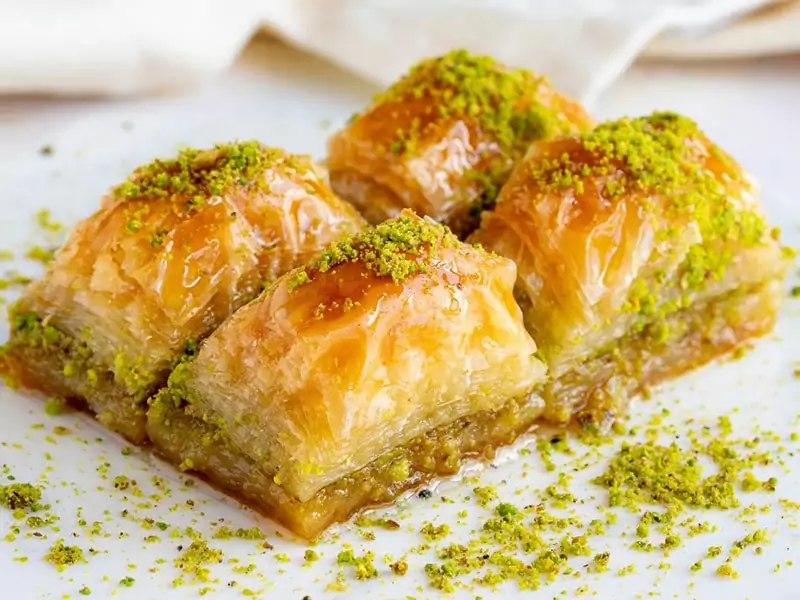
This layered phyllo pastry is generously filled with chopped nuts, then sweetened to perfection with syrup or honey. It’s a celebrated dessert and street food in various Middle Eastern countries, such as Turkey and Iran.
But many other regions, like the Balkans and Eastern Europe, love it, too. There are subtle differences in how different countries prepare baklava.
For instance, Turkish Baklava has a fondness for more syrup and fewer nuts than its Greek counterpart. Meanwhile, Iranians prefer baklava with a drier, more compact form in small diamond shapes.
Hummus (Chickpea-Based Dip)
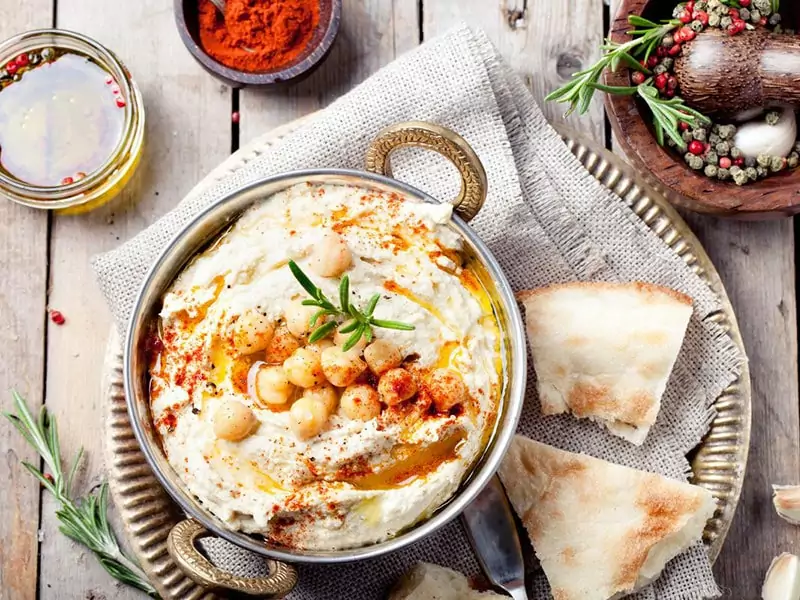
This creamy, lemony, garlicky dip is a beloved street food across the Middle East, from Israel and Palestine to Lebanon and Egypt. The key to its charm is the harmony of mashed chickpeas, tahini, lemon, garlic, and olive oil.
Israelis often pair hummus with pita bread and raw onion pieces, while in other countries, it takes center stage at breakfast or brunch. It’s not just a treat for the palate but also a healthy choice when enjoyed in moderation, given its nutrient-rich ingredients.
Hummus is remarkably simple to whip up at home. All you need is a food processor to puree the ingredients until smooth. You can also use the appliance to prepare Baba Ganoush, a similar Levantine eggplant-based dip.
Turkey
Ayran (Yogurt Drink)

This yogurt-based beverage has a rich history and traces its roots to Turkey. It is also quite a star in Central Asia, Western Asia, and Eastern Europe. This thick, creamy drink is known as Doogh in Iran. Its balanced flavor of yogurt, salt, and water is a true palate-pleaser.
Ayran is often served chilled, a boon during hot summer days. For these reasons, I find this refreshing drink perfect for Middle Eastern and Mediterranean meals, especially grilled meat and rice dishes.
As Aryan is available in many countries, there are plenty of versions out there, all offering the iconic tangy and salty goodness. Aside from its delightful taste, the yogurt drink can bring a health boost thanks to containing a lot of probiotics, minerals (especially calcium), and vitamins.
Börek/Burek (Savory Pastry)
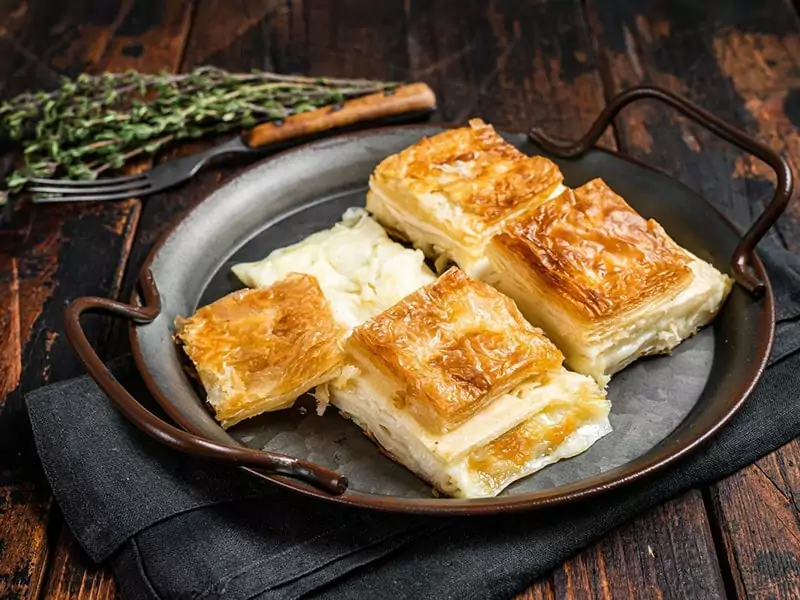
Börek (Burek) is a famous pastry in the Middle East, the Balkans, and Central Asia. In Turkey, it is a breakfast and brunch staple. Think of it as a pie, with a thin, flaky dough similar to phyllo and various fillings, such as meat, potatoes, cheese, eggs, spinach, and other vegetables.
This savory pastry comes in many shapes and sizes, and the ingredient combination possibilities are endless. I recommend you to try Su Böreği, in which the dough and filling are boiled before being baked.
If possible, you should also try the crunchy Paçanga Böreği (filled with diced green pepper and tomatoes) and the Çiğ Börek (a half-moon-shaped version filled with minced meat and onions).
Revani (Semolina Cake)
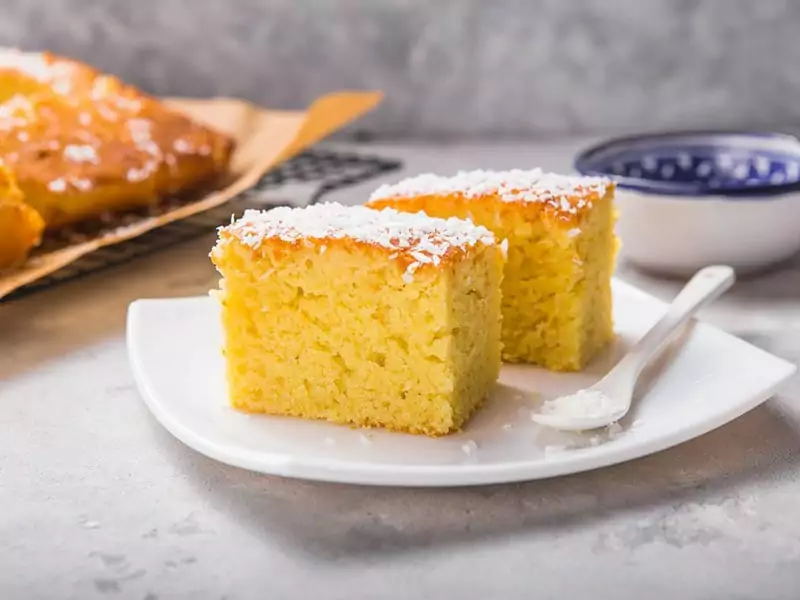
Here is a traditional Turkish semolina dessert you can find all over the Middle East and Mediterranean. The yellow cake’s texture is sinfully soft and tasty thanks to being steeped in the lemony syrup.
The contrast between the rich, dense cake and the bright citrus goodness is simply delectable. The addition of chopped nuts, often pistachios, perfects the treat with a delectable crunch. Traditionally, Revani is available in square or diamond-shaped pieces.
Lahmacun (Turkish Pizza)
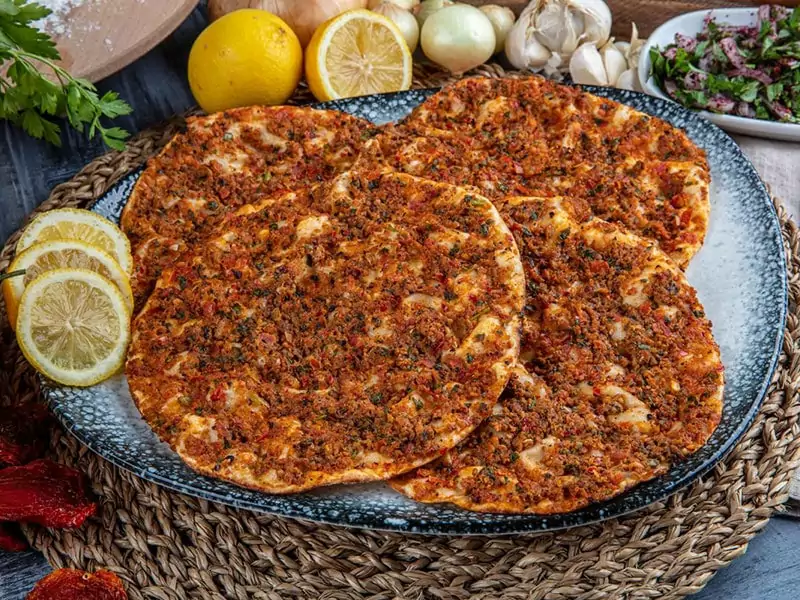
Many people like to refer to Lahmacun (pronounced lah-ma-joun) as Turkish pizza, and the similarities between the two are enough to guarantee that name. This staple in Turkish street food enjoys an avid fanbase in Syria, Lebanon, and Armenia.
Its Arabic name gives a hint to its delicious simplicity – “dough with meat.” This dish consists of a round, ultra-thin, crispy flatbread that carries a topping of spiced minced meat. But it doesn’t contain cheese-laden toppings you might expect on traditional pizza.
The beauty of Lahmacun lies in the contrast between the rich, aromatic meat and the crispness of the bread. The best way to enjoy it is to add a drizzle of lemon juice while it is still hot and dig in.
Turkish Coffee
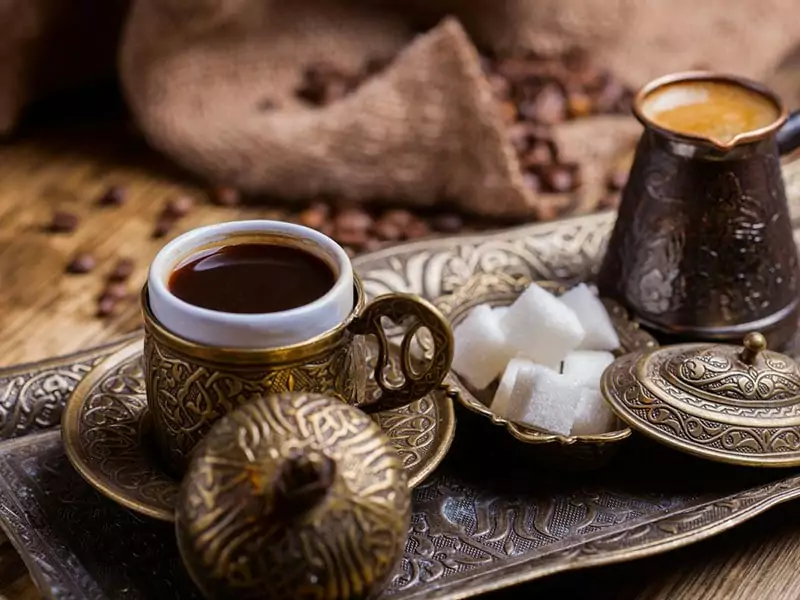
Turkish coffee is thick and unfiltered, which is a far cry from the usual brews that Westerners are familiar with. It uses finely ground coffee beans, preferably of the superior Arabica variety. This raw mixture is placed in a cezve, a small, long-handled pot native to Turkey.
Such a high-quality ingredient ensures that Turkish coffee is always richer than the regular stuff. It is always served alone or with some sugar in a small kahve fincanı cup. You can balance the intense flavor with something sweet on the side, such as Turkish delight.
Kadayıf Dolma (Fried Dessert With Shredded Phyllo Dough And A Walnut Filling)
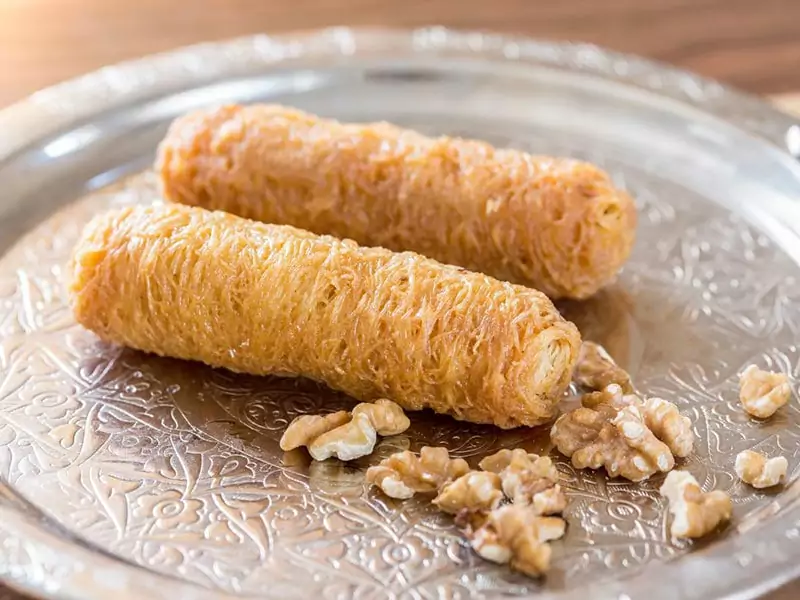
This mouth-watering dessert punctuates many Turkish holidays and special celebrations. Its main ingredients are kadayıf (slender shreds of phyllo pastry) filled with chopped nuts and sweet syrup. Once full, these pastry sheets are meticulously rolled into elongated forms.
But the Kadayıf Dolma’s journey isn’t over. Each roll must be dipped in a beaten egg and then fried until crispy. Pair this sweet, nutty treat with a warm cup of tea or coffee, and you will find yourself sighing with pleasure.
19. Simit (Turkish Sesame Bread)
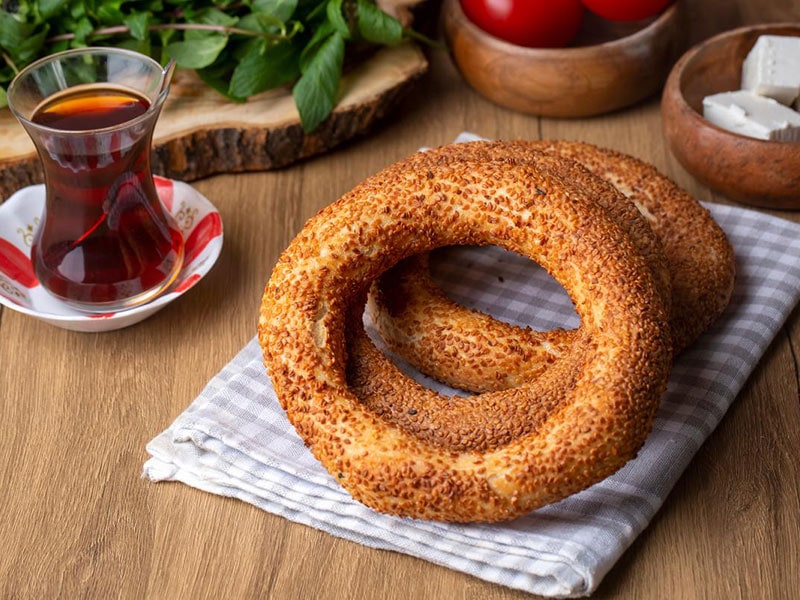
Americans often call it Turkish bagels, but its true name is Simit. Picture a circular bread, strikingly similar to an American bagel yet subtly sweeter, and you will know what this Turkish treat is like.
Simit is typically coated with sesame seeds, although variations with sunflower or poppy seeds also exist. Bite into it, and you’ll find a delightful contrast between the crunchy exterior and the soft, slightly chewy interior. The nutty flavor is another reason to love it.
Many Turkish streets have Simit vendors, recognizable from their trolleys or trays balanced atop their heads. Simit is a breakfast favorite enjoyed with tea or Aryan, cheese, cucumbers, or tomatoes.
It is one of the most affordable street foods, making it popular with the lower and middle classes.
Lebanon
20. Arayes (Meat Stuffed Pita)
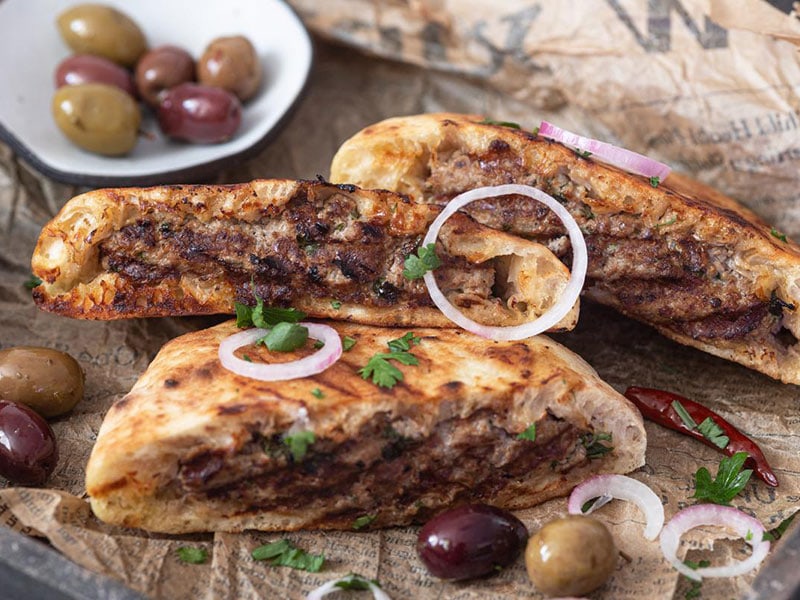
It’s impossible to describe Lebanese and Syrian street foods without mentioning Arayes, a delicious on-the-go treat. It’s all about a grilled or oven-baked pita bread pocket filled with a Kofta-like meat mixture.
The choice of meat is typically beef seasoned with easy-to-find spices and herbs. The final touch is often a drizzle of tahini sauce or yogurt. Given such simplicity, it is very easy to prepare Arayes at home.
21. Manakish / Manaeesh (Cheese Pita)
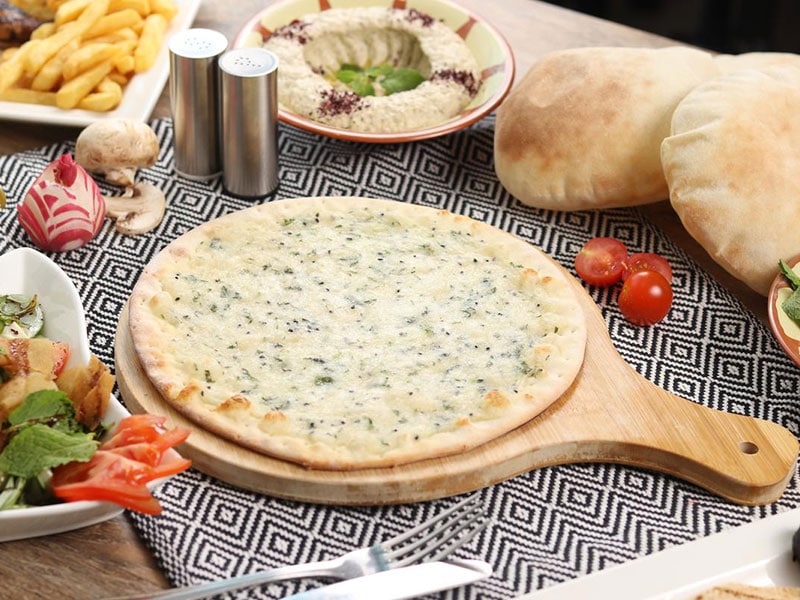
This Levantine culinary icon bears a striking resemblance to pizzas yet comes with a unique Middle Eastern twist. Those ingredients make it completely different from the Italian version: spinach, chili, the spice mixture Za’atar, minced lamb, and local cheese.
The combo of Akkawi (a white cheese) and Kashkaval (made from cow’s milk) creates an undeniably luscious flavor. Whether sliced like pizza or folded over, Manakish is always perfect for breakfast or lunch.
22. Kibbeh (Meatball Made With Bulgur And Meat)
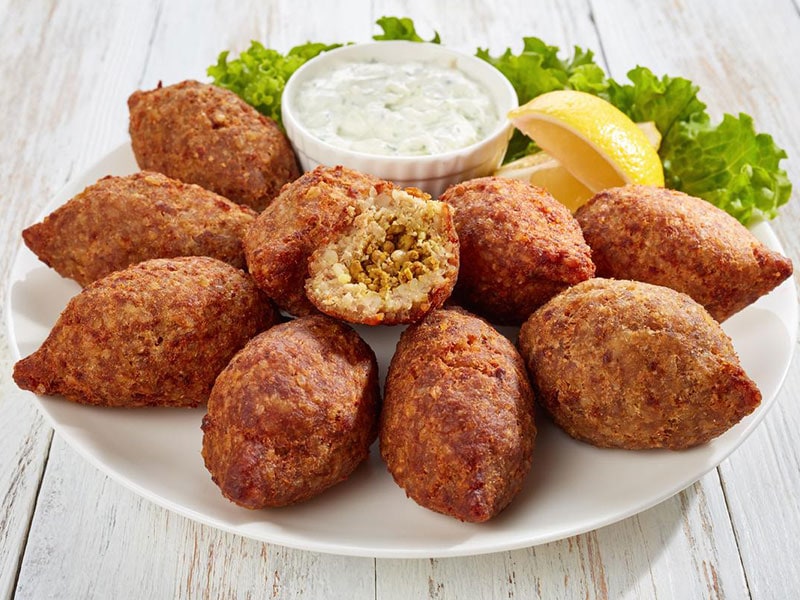
Lauded as a national dish in Lebanon and Syria, Kibbeh is a must-try dish for lovers of Middle Eastern cuisine. It has some connections with the famous Çiğ Köfte (Turkish-style steak tartare). The dish consists of ground lamb or beef mingled with fine bulgur wheat, pine nuts, and plenty of spices.
This flavorful mixture is then shaped into oblong balls (“Kibbeh’” fittingly means “to form into a ball”) and finds its destiny in the deep fryer or on the grill, attaining a captivating golden brown hue. Kibbeh Nayeh, a raw variant of Kibbeh, is an intriguing option for adventurous foodies.
While government agencies may warn against eating it [1], Kibbeh Nayeh may be a very enjoyable treat if sourced from reliable vendors.
Anyway, even if you skip it, there are many other delicious Kibbeh variations in Egypt, Iraq, Iran, and Palestine. They are best relished with a crisp salad or doused in a yogurt garlic sauce.
23. Fatayer (Savory Hand Pies)
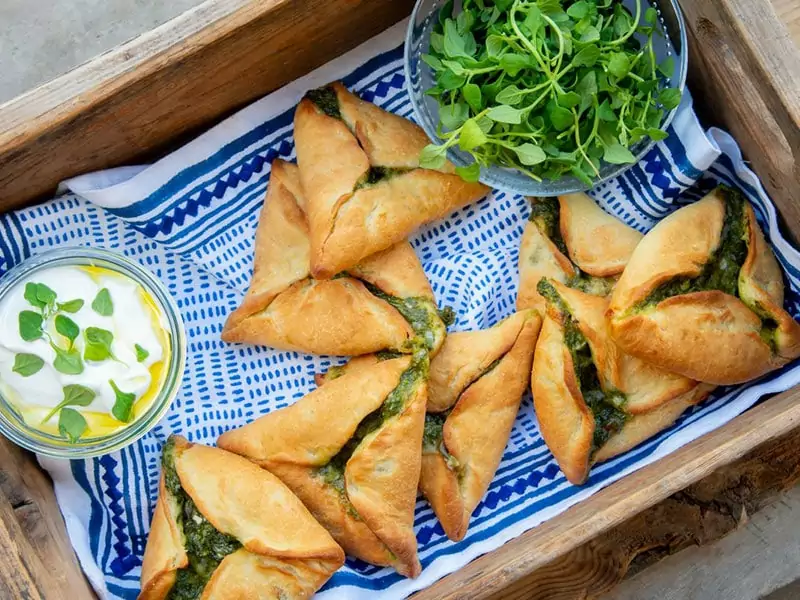
Originating from the Levant, this savory pastry has found its home in Lebanon, Syria, Iraq, Egypt, and beyond. Besides common ingredients like flour, yeast, water, sugar, and salt, some cooks incorporate yogurt or olive oil into the mix for a richer taste.
If you have a soft spot for samosas, you will love Fatayer, too! It took me a few trips to several Middle Eastern restaurants to know that Fatayer can have many types of fillings, like cheese, lamb, or spinach (this version is called Fatayer Sabanekh).
You can guess what is inside from the shape. Spinach Fatayer has a triangular shape, while a meaty variant looks like a boat. Regardless of the filling, Fatayer is always baked until golden and crispy. It is an amazing appetizer or snack, especially with yogurt or a fresh salad on the side.
24. Shish Tawook (Yogurt-Marinated Chicken Kebab)
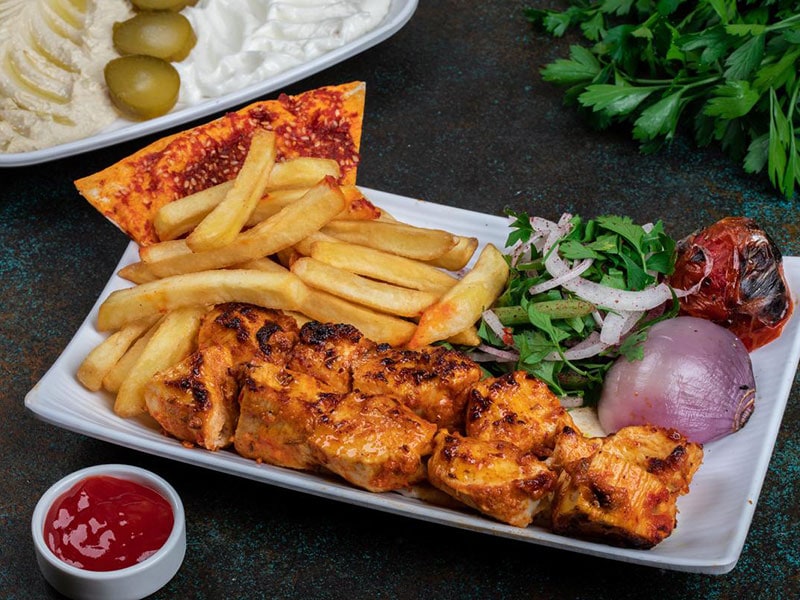
In case you’re tired of red meat, savor this popular Lebanese chicken skewer! As an integral part of Middle Eastern cuisine, these skewers include juicy and flavorful chicken pieces. The marinade, a blend of yogurt, garlic, olive oil, lemon juice, and spices, is responsible for that richness.
After being skillfully grilled, the chicken takes on a good-looking char. In Lebanon, the skewers are traditionally served hot with a robust garlic sauce known as toum. Meanwhile, Turkish people complement Shish Tawook with a side of fluffy rice.
Palestine
25. Maamoul (Filled Cookies)

Maamoul cookies, which literally translates to “stuffed,” are a must-have treat for Palestinian Christians during Easter and Christmas. Muslims love Maamoul, too, and widely enjoy the cookie during Eid al-Fitr (the holiday that marks the end of Ramadan).
The exterior of this Levantine sweet treat is derived from farina (a type of milled wheat), butter, yeast, mastic gum, and sugar. For the filling, you’ll experience a combo of date paste (or other nuts), butter, and spices. They come together to create a sweet and buttery delight.
Ka’ak al Quds (Jerusalem Sesame Bread)
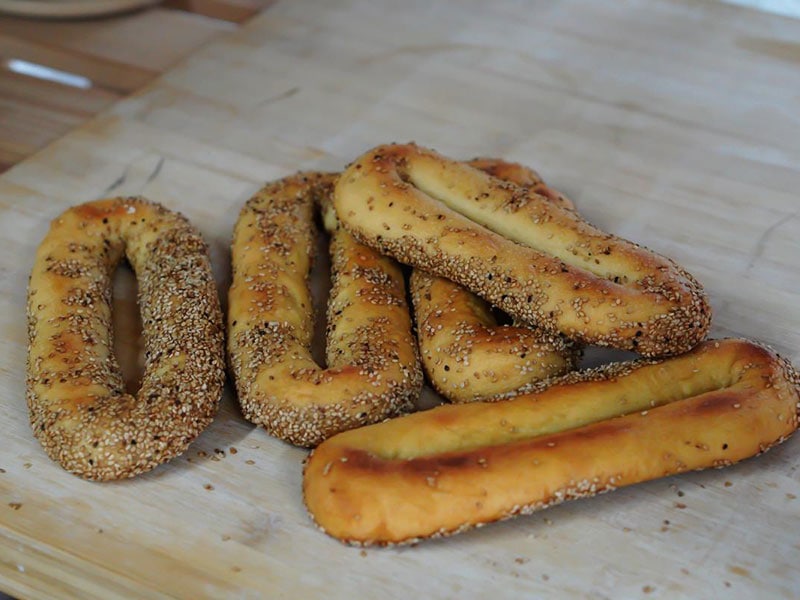
Meet Ka’ak al Quds, a well-known baked treat in bakeries and roadside stalls around Jerusalem. Its oblong shape and abundance of sesame seeds on the exterior often remind me of Turkish Simit and Polish Obwarzanki. Like those treats, Ka’ak al Quds is a snack and breakfast staple.
To take full advantage of its crispy crust and soft inside, you should munch on the bread right after baking. Want to add an extra layer of flavor? Simply dip a piece into a mix of olive oil and dried thyme for that herbaceous goodness.
Oman
27. Khubz Raga (Omani Bread)
If you mistake this Oman bread for pita or naan, you’re not alone. In terms of ingredients, it is a culinary minimalist’s dream, consisting of only flour, water, and salt. The result is a very thin flatbread best served warm.
Khubz Raga can accompany many dishes, from breakfast to dinner. Try topping it with a pat of butter, a scrambled egg, or some cheese.
28. Karak Chai / Karak Tea
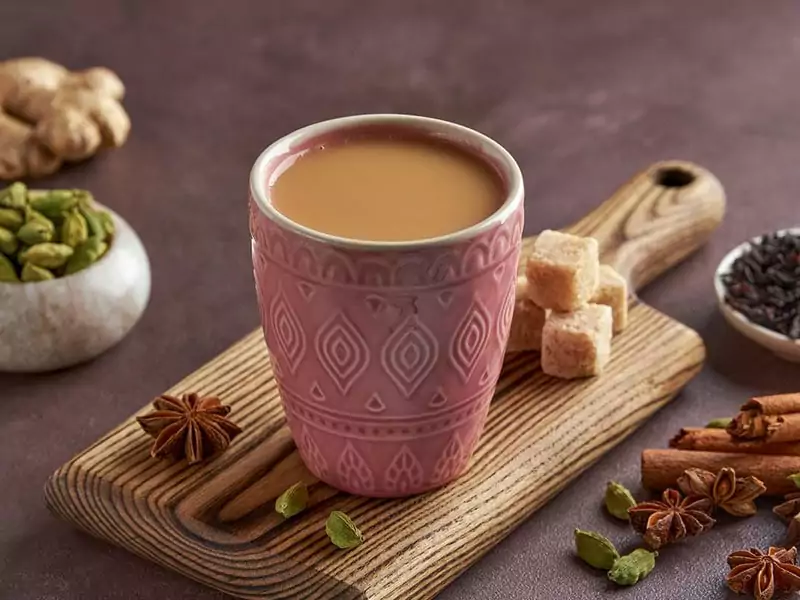
Since Karak Chai came from India, it’s a blend of black tea, condensed milk, and a melange of spices like ginger, cardamom, cinnamon, and cloves. Therefore, it is sweet, creamy, and more flavorful than English tea.
You can easily buy this Oman drink from shops and stalls on the street. It isn’t just for sipping but also a delightful accompaniment to any snack.
Mishkak (Skewered And Grilled Meat)
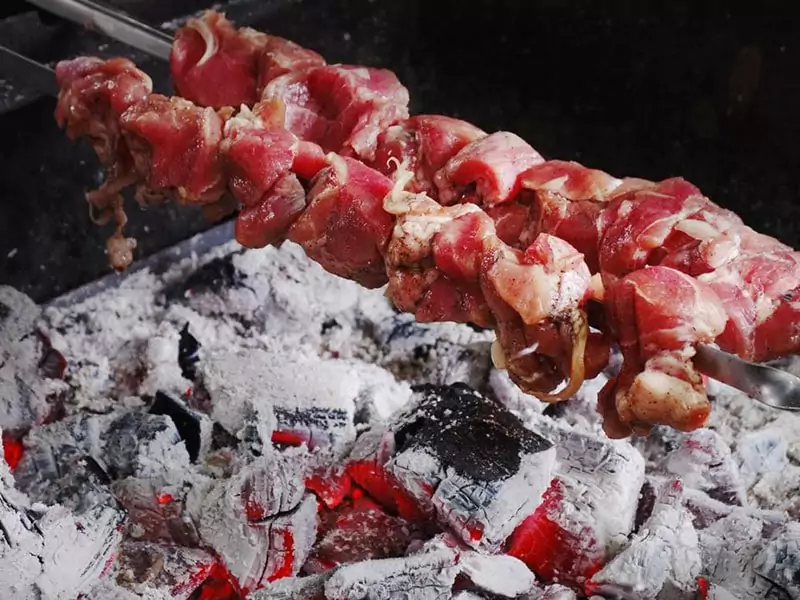
Mishkak is a different take on kebabs. It is a carnival of flavors, with skewered meat (like beef, mutton, or chicken) as the main player. But the meat must be carefully marinated first, preferably in a mixture of yogurt, tamarind sauce, and spices like cloves, cumin, and chili pepper.
This grilled meat dish is typically served with a side salad, tamarind chutney, or chili sauce. If you’re looking for a hearty bite, you can even stuff it inside a warm piece of bread.
Egypt
Ful Medames (Stewed Dried Beans)
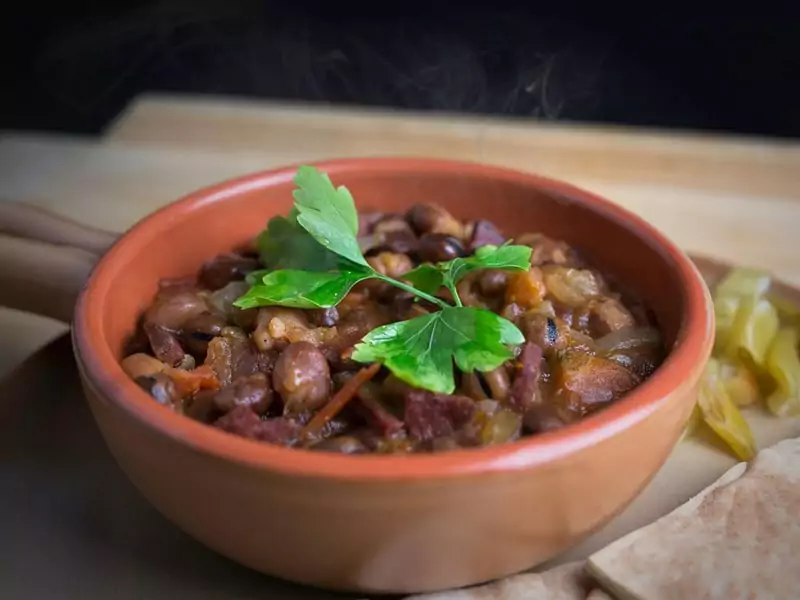
One of Egypt’s most beloved dishes is Ful Medames, the king of the local street food scene. It’s a hearty stew of fava beans, tomatoes, olive oil, and many aromatic spices. Chopped parsley sprinkled on top adds a burst of freshness to this comfort food.
The resulting dish offers a creamy and filling feast with a distinctive nutty undertone. While Ful Medames is suitable for any time of the day, locals have a penchant for starting their day with it. It can also be stuffed into a warm pita to become a sandwich.
Hawawshi (Meat-Stuffed Pita)
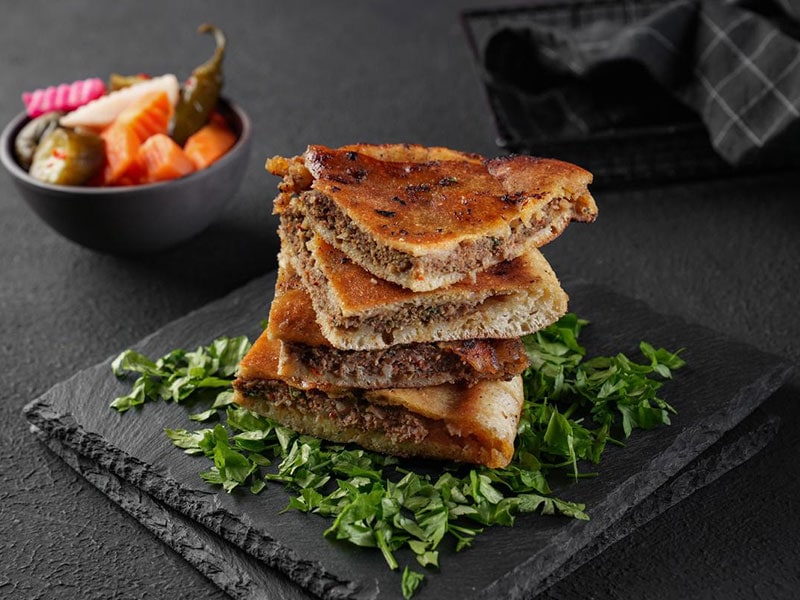
Back in 1971, an Egyptian butcher named Ahmed al-Hawawsh came up with a fast food item that would keep his name immortal: Hawawshi.
It features a pita pocket filled with minced meat, peppers, onions, spices, and parsley. The stuffed pita is then roasted in an oven and sliced into smaller, bite-sized portions.
Whether at local street stalls or take-away restaurants, Hawawshi is always a fixture in Egypt’s fast food and street food cultures. It is extremely easy to find around Cairo and Alexandria. To enjoy Hawawshi like a local, you should pair it with salads or sliced veggies.
Koshari (Savory Dish With Lentils, Rice, And Pasta)
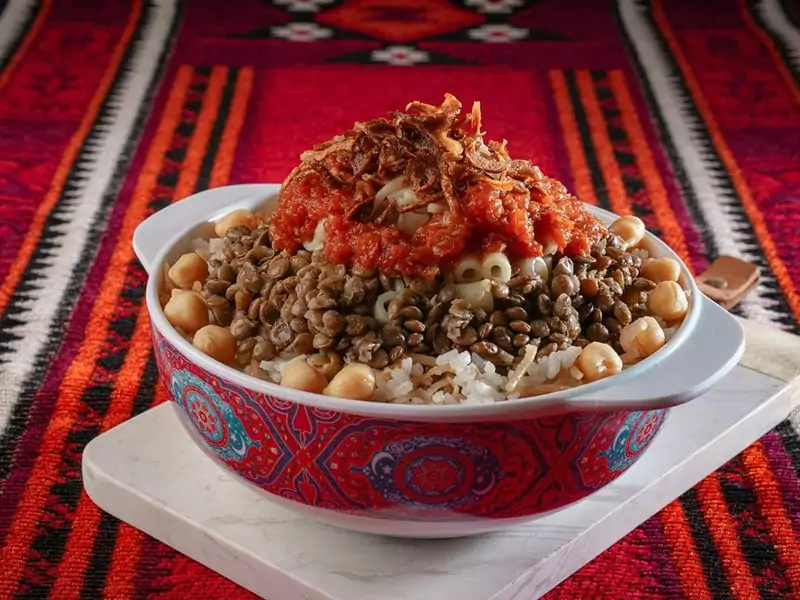
This flavorful and vegan-friendly street food item is a model of culinary simplicity. It only includes easy-to-find ingredients, such as rice, pasta, lentils, chickpeas, tangy tomato sauce, and fried onion rings for toppings. For an extra flavor kick, garlic vinegar or hot sauce are the right condiments.
While the ingredient list is humble, its flavor is anything but. While this budget-friendly meal is often dubbed “the poor man’s food,” it also possesses a more impressive title: Egypt’s national dish. You can find variations of it in other countries, such as Yemen and Eastern Arabia.
Fiteer (Egyptian Layered Pastry)
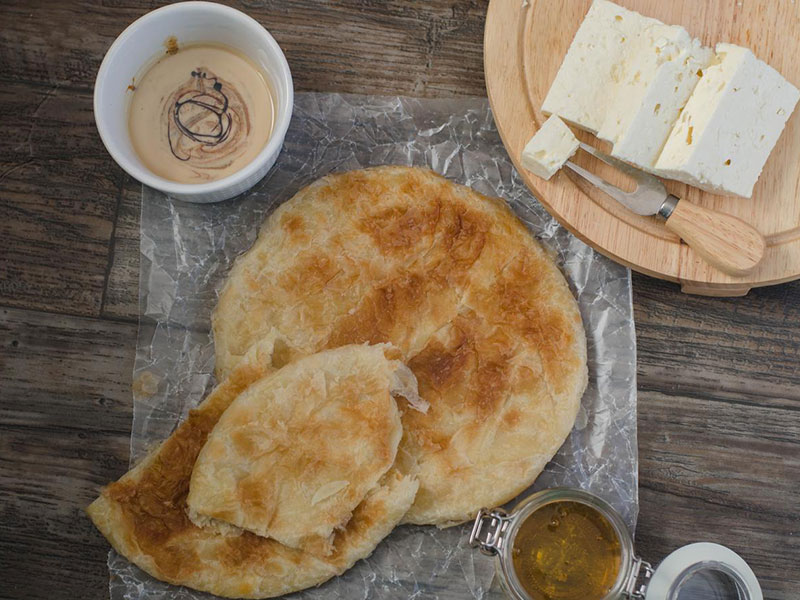
A few Middle Eastern baked goods look like Italian pizzas, and Fiteer is one of them. It’s an irresistible pastry consisting of multiple thin layers of flaky dough anointed with ghee. Then comes the choice of filling, which can fall on the sweet or savory side.
For the former, you can go for things like cheese, Nutella, Malban (fruit jelly), coconut, or icing sugar. Those in the savory camp can choose ground meat, cheese, or sausage.
Fiteer is a superb snack for any time of day. During my time in Egypt, I used it to satiate both my mid-day hunger pangs and late-night cravings.
Morocco
Tagine/Tajine (Moroccan Slow-cooked Meat)
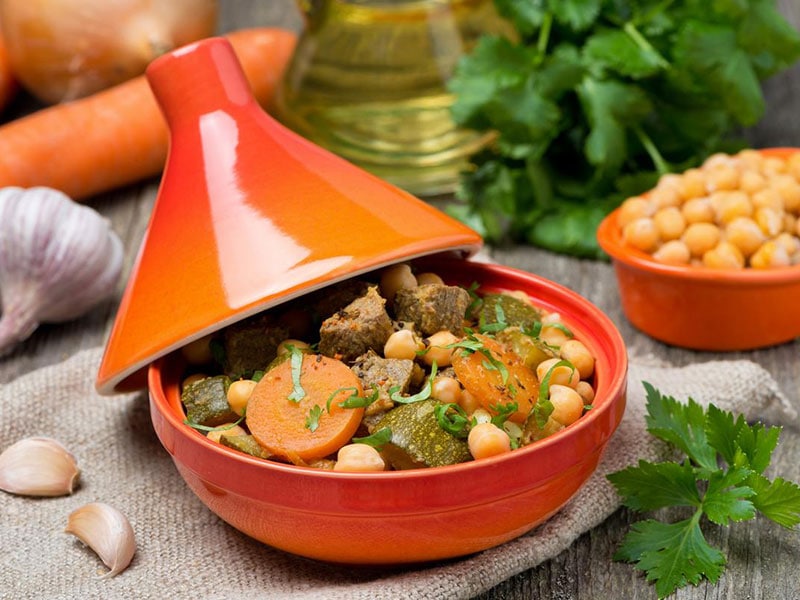
Tagine is the name of a traditional Moroccan dish and the unique cone-shaped cookware used to prepare it. The dish is a slow-cooked savory stew made from succulent lamb, chicken, or fish. The protein is cooked alongside many vegetables and spices, like saffron, cumin, and ginger.
Off the top of my head, I can name a few famous variants: Tagine D’Agneau (lamb and fruits like prunes or apricots), Tagine du Poulet (chicken, preserved lemon, and olives), and Tagine du Berber (with less meat and more vegetables).
The accepted etiquette to serve Tagine is to hold a piece of bread in your right hand and use it to scoop up the delicious stew. While eating Tagine is often a communal experience, you can enjoy it solo in street food stalls and restaurants.
B’ssara (Fava Bean Soup)
A soup made from dried fava beans, B’ssara holds a special place in breakfast routines across Morocco. Not only is this traditional dish a wallet-friendly choice, but its compatibility with vegan, vegetarian, and gluten-free diets also makes it a hit among many food enthusiasts.
Its warmth and hearty quality make B’ssara a crowd favorite during the chillier months. Many people like to serve it with bread for a complete meal. To find it, keep an eye out in town squares and alleyways, or follow the irresistible aroma wafting from street food stalls.
Brochettes (Moroccan Kebab)
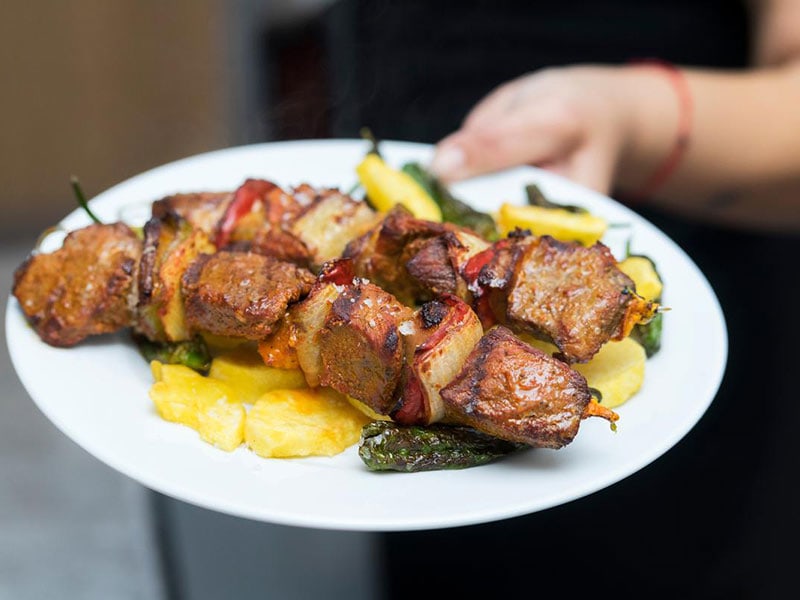
These Moroccan-style kebabs can feature many types of meats, including chicken, lamb, beef, or even fish. As you bite into them, you’ll notice a similar flavor to Shish Kebabs from Turkey.
However, the Moroccan twist lies in the addition of suet (saturated fat) between the meat cubes, lending more moisture and richness to the meat. Street vendors serve these tasty morsels all year round, but the fragrance of homemade Brochettes often fills the air during Eid-al-Adha.
Msemen (Moroccan Square Bread)
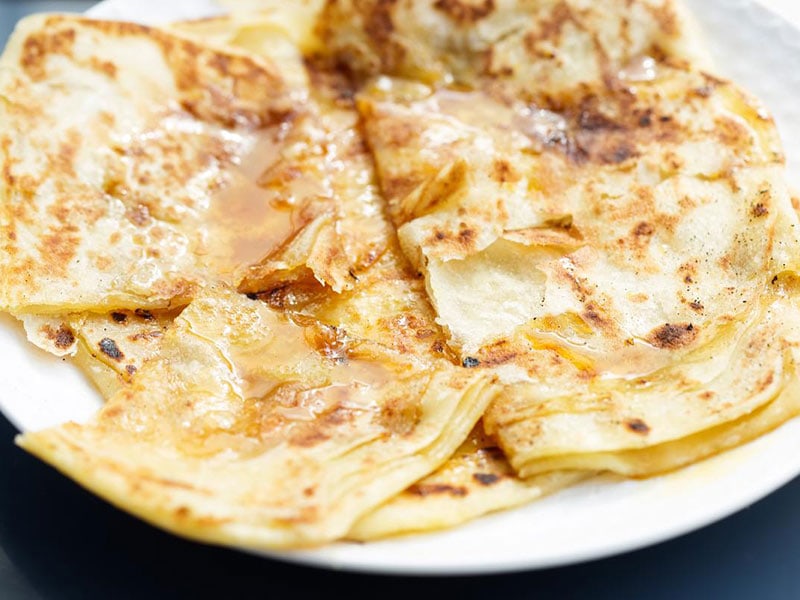
Msemen (or Rghaif) is a vital facet of Moroccan cuisine and culture. Each morning, locals sip their coffee or tea while nibbling on this square bread.
The simplicity of its ingredients (flour, semolina, salt, yeast, and water) belies the multiple layers of deliciousness that await inside. Some versions leave out yeast or are stuffed with meat or veggies.
Street food vendors often prepare Msemen early in the day by cooking them on a hot griddle, creating crispy and mildly flavored bites while filling the cool morning air with a delicious aroma.
Beghrir/ Baghrir (Semolina Pancake)
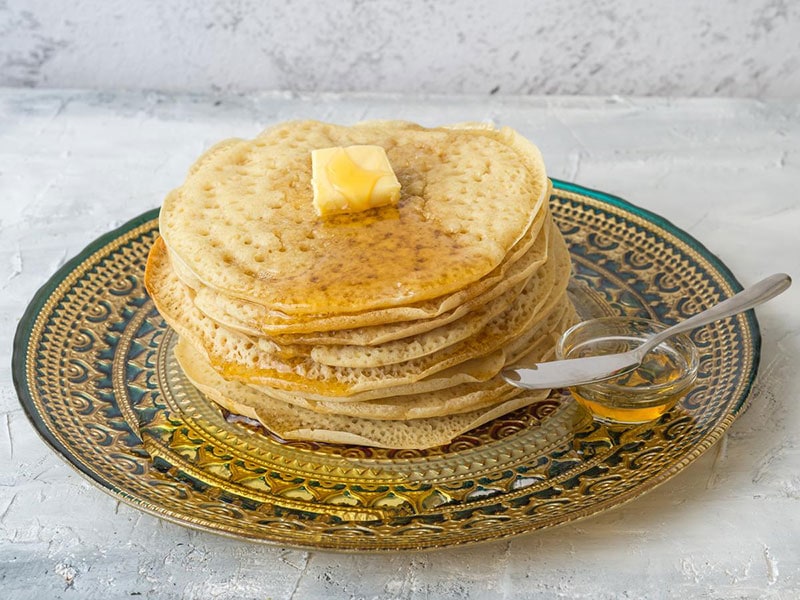
Made of semolina, Beghrir is very different from ordinary pancakes. The flour gives it a distinct feel and many tiny holes on top. One bite into this spongy, tender pancake, and its lightness will be a treat for your taste buds. In Morocco, it’s a breakfast favorite and a snack-time staple.
But the ideal time for Beghrir is during Ramadan when it is served at iftar, the meal after sunset. Let me tell you an insider’s tip: dip the pancake in a honey-butter mixture, as locals do. You could also pair it with jam for a sweet twist.
Syria
Booza (Frozen Dairy Dessert)
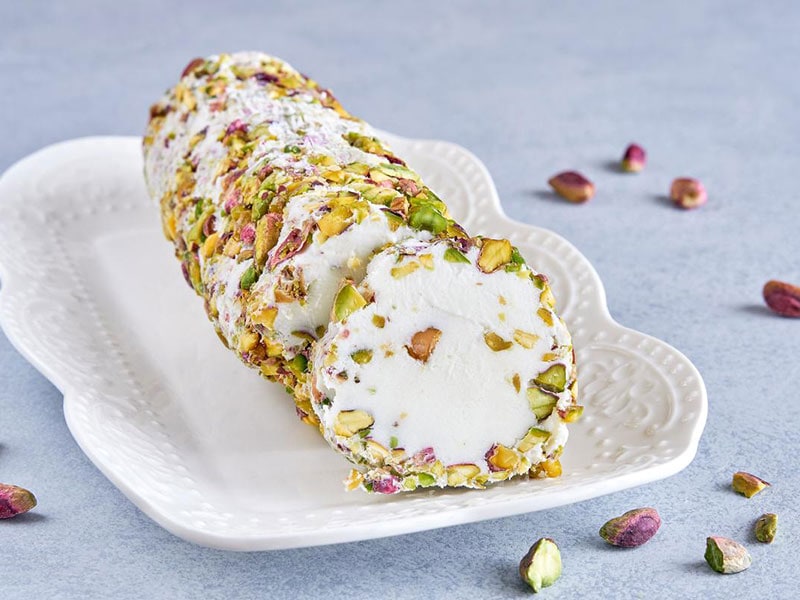
This Middle Eastern dairy dessert dates back to at least the 16th century in Greater Syria. In addition to cream, milk, and sugar, it includes several distinctly Oriental ingredients, such as mastic (a raisin from the mastic tree) and salep (the flour made of wild orchid tubers).
Moreover, the traditional pounding and stretching process used to create the ice cream gives it a pleasantly stretchy and chewy texture. My first taste of Booza was the classic Kashta variety, which features clotted cream, rose water, and orange blossom.
But there are many other flavors that I can’t wait to discover. Booza is a part of everyday life in Syria. You can find it in street stalls and ice cream shops.
Kebab Karaz (Kebab In Cherry Sauce)
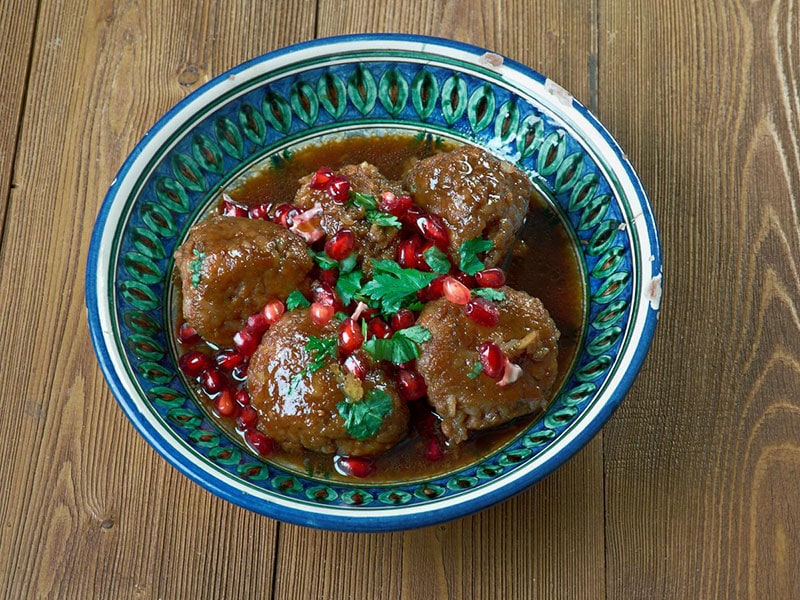
This version of kebab is strongly associated with Aleppo, Syria, and is also famous in other countries like Armenia, Lebanon, and Israel. True to its name (literally “cherry kebab”), this yummy features spiced minced lamb or beef simmered in a cherry sauce.
The authentic version calls for St. Lucie cherries, known for their smaller size and a perfect blend of sweet and sour flavors. To truly savor Kebab Karaz, you can enjoy it by hand, scooping up tender meat and sauce with a piece of bread.
Kebab Halabi (Kebab In Tomato Sauce)
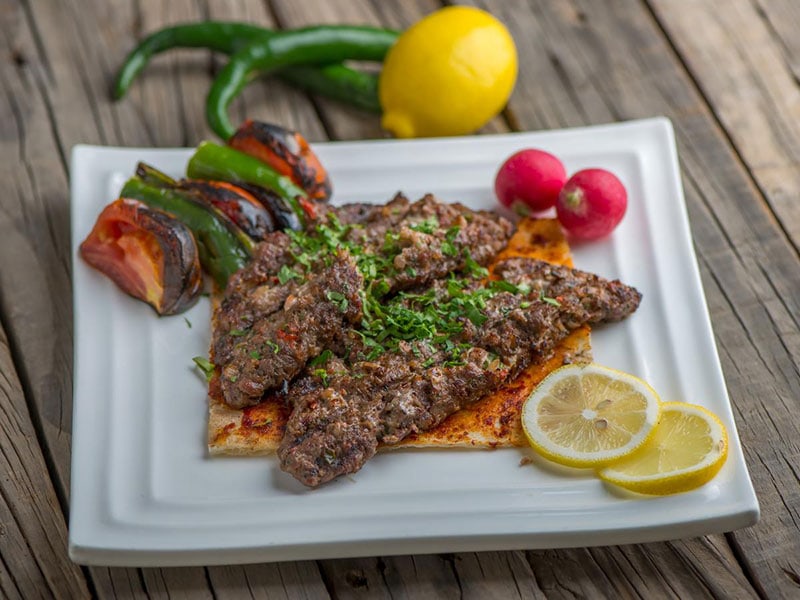
Here is another delicacy from Aleppo, which was named after the city itself: Halab is the Arabic name of Aleppo. Outside Syria, this kebab variation is also well-known in Lebanon.
Kebab Halabi includes grilled meat served with a tantalizing tomato sauce and Aleppo pepper. If you have a fondness for spicy flavors, it will surely satisfy your cravings.
Iran
Borani Esfenaj (Yogurt-Based Dip)
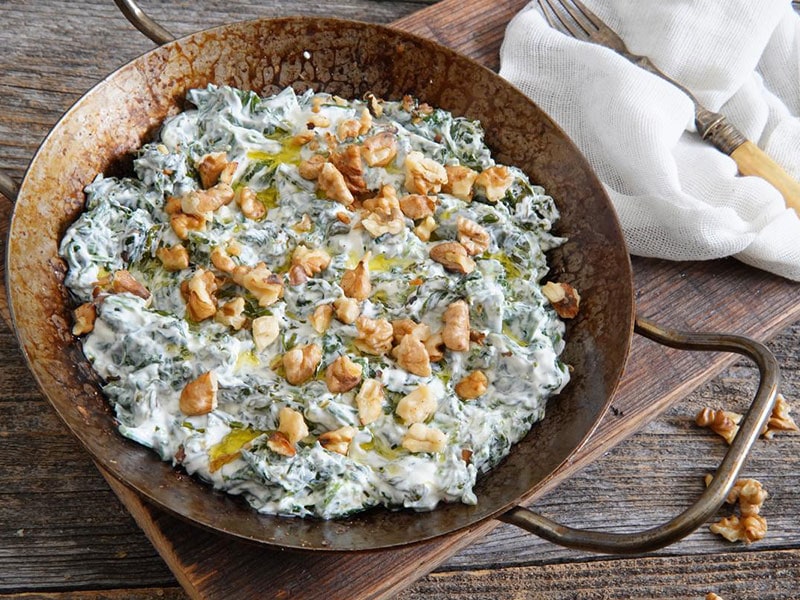
Borani Esfenaj is a perfect Persian-style dip that caters to vegetarian palates. It contains a harmonious blend of yogurt, cooked vegetables (usually spinach), and walnuts. Everything is mixed until a milky-white paste with splashes of green spinach emerges.
Whether you’re looking for a quick snack (by serving the dip with bread) or an appetizer to impress your guests, Borani Esfenaj is the perfect choice. It is very flavorful thanks to the pleasant tang and nutty undertones.
Halva (Middle Eastern Sweet Confection)
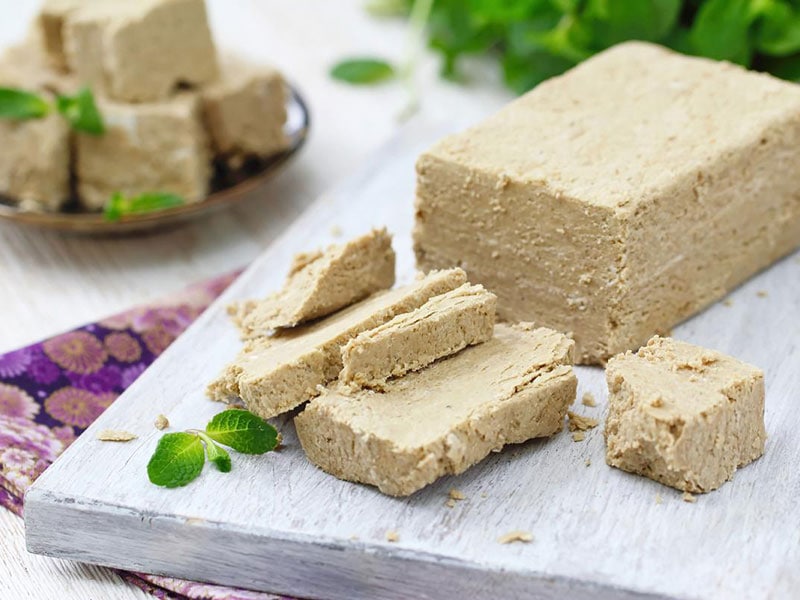
Halva, meaning “sweet” in Arabic, is a type of tasty confectionery enjoyed in Iran, Greece, India, and beyond. Locals derive it from a simple mixture of ingredients such as wheat flour, butter, rose water, and saffron, among other things.
The result is a treat with a sweet taste and velvety texture in a dark brown color. The mixture is spread thinly on a plate and left to dry into a paste-like consistency. Halva appears at various important events, like funerals, weddings, and religious ceremonies.
Aush Reshteh/ Ash Reshteh (Persian Noodle Soup)
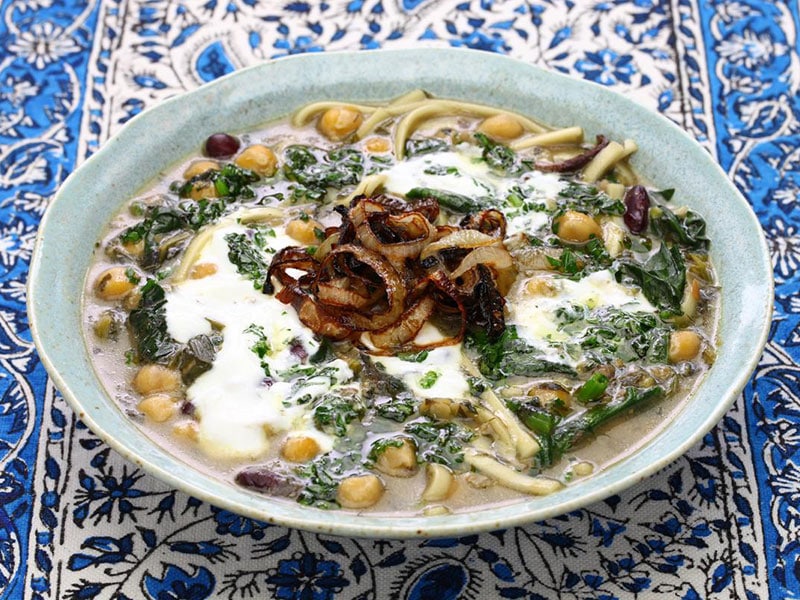
This thick noodle soup has reshteh (thin noodles) as the base. That kind of noodle symbolizes good luck, giving the dish a special status. Aush Reshteh also contains an array of greens, legumes (like kidney beans, dried chickpeas, and green lentils), kashk (dried yogurt), and herbs.
Aush Reshteh is a wholesome vegetarian delight packed with nutrients and ideal for autumn and winter. It holds a special place in cultural celebrations like Nowruz (Persian New Year) and Sizdah be-dar (Nature’s Day).
Sangak (Iranian Flatbread)
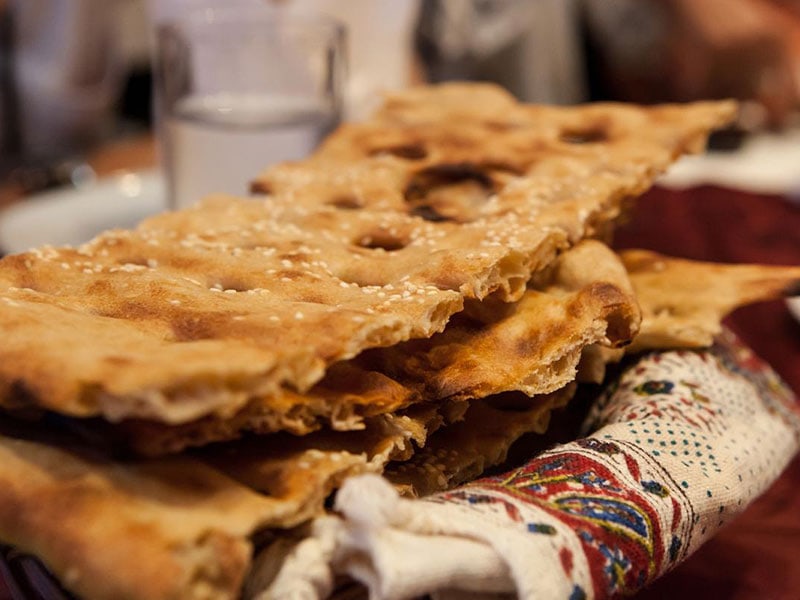
This bread is created from leavened whole wheat dough and is typically baked on a bed of small river stones in a hot oven. Perhaps that is the source of its interesting name: “sangak” means “little stone” in Persian. The oblong shape and uneven surface also enhance that rustic appeal.
The flatbread can come with or without toppings. Toppings can include sesame seeds or poppy seeds. Best enjoyed warm, Sangak pairs wonderfully with a yogurt shallot dip.
Israel
Shakshuka (Poached Eggs in Spicy Tomato Sauce)
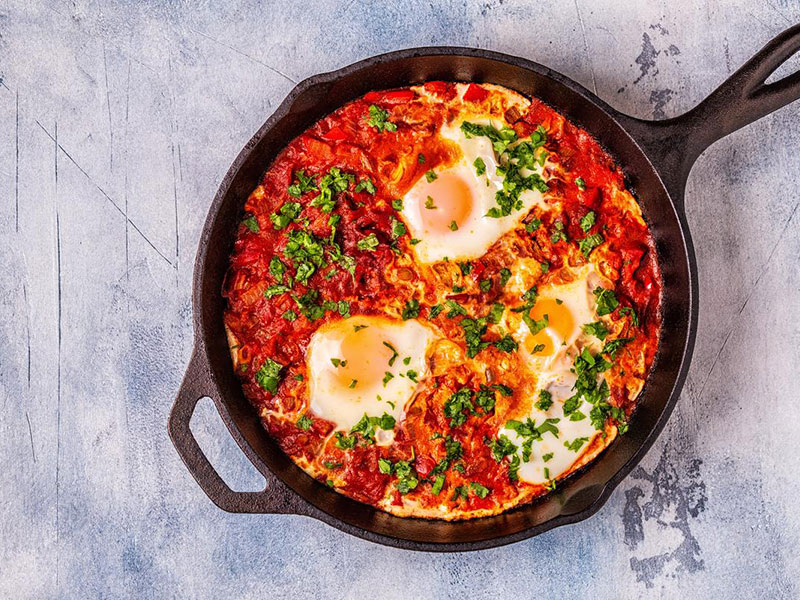
Shakshuka was originally a North African dish that Jewish immigrants brought to Israel. Today, it is a popular and healthy choice for breakfast or an evening meal. This flavorful dish consists of poached eggs cooked in a vibrant tomato-based sauce with aromatic spices.
Israelis usually serve Shakshuka with bread or a side salad for a well-rounded meal. You can find it at street vendors or restaurants across Israel as well as North Africa.
Malawach (Israeli Flatbread)
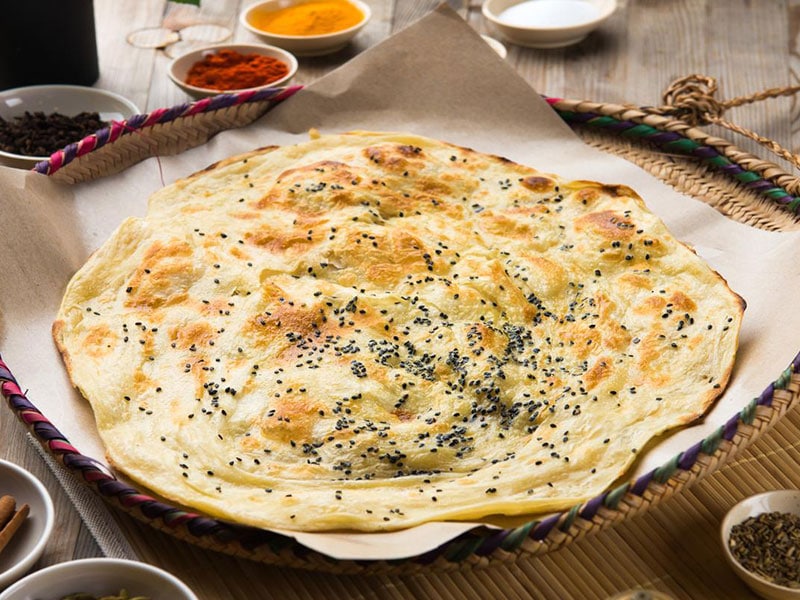
A beloved dish in Yemenite Jewish cuisine, Malawach found its way to Israel through the Yemenite Jewish community. This mouthwatering flatbread offers a buttery, flaky, and crispy texture. The dough is fried in a small amount of oil until golden brown.
Malawach is a wonderful wrap for sandwiches. It can also accompany dishes like Shakshuka, hummus, hard-boiled eggs, tomato dip, and zhug (a spicy green sauce). Many Israelis love to have Malawach for breakfast.
Malabi (Rose Water Milk Pudding)
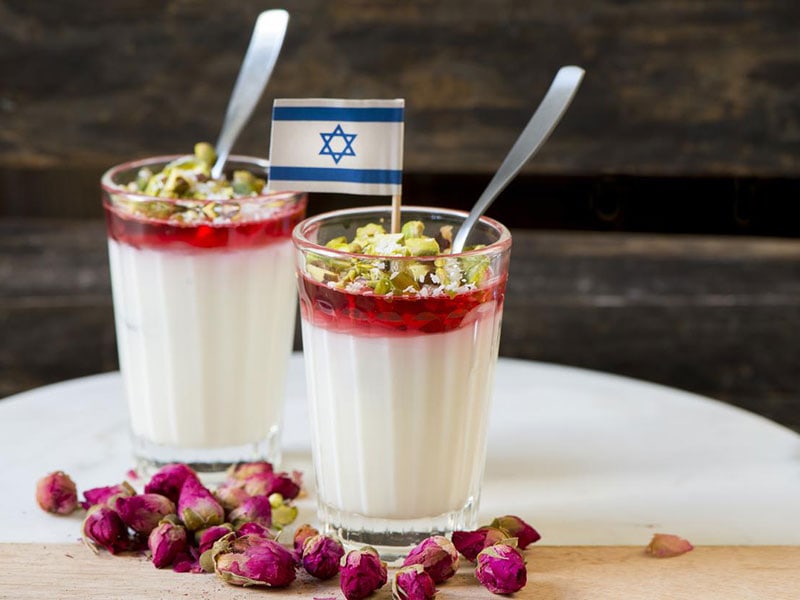
This fragrant milk pudding is a famous dessert in Israel. It is made with a mixture of flour, milk, and rose water, plus a lot of sweet fruit-based syrup for serving. The syrup is often ruby-red since its main ingredient is raspberries, strawberries, or pomegranates.
The combination of the smooth and creamy texture and the subtle sweetness makes Malabi a true indulgence. Don’t forget to serve it chilled.
Iraq
Kleicha (Date Cookies)

Kleicha refers to a pastry delight filled with luscious dates. It is available in various shapes, with the most common one resembling a pinwheel. The treat strikes a perfect balance of moderate sweetness without being overly greasy.
The best way to enjoy Kleicha is with a cup of dark Iraqi red tea so that the mellow flavor of Kleicha can cut through the bitterness of the tea. These cute cookies are ubiquitous during Eid al-Fitr.
Masgouf (Grilled Fish)
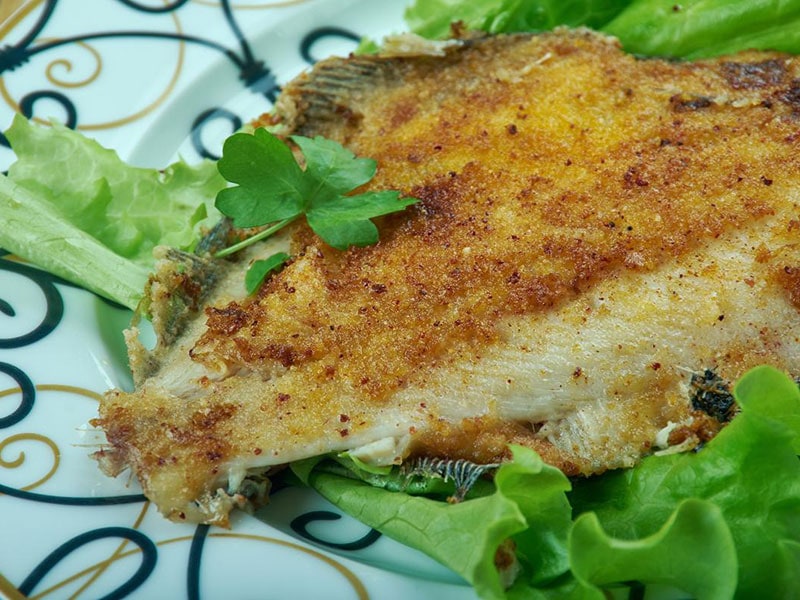
Considered the national dish of Iraq, Masgouf holds a special place in the hearts of locals, especially in cities along the picturesque river Tigris. This seasoned and grilled fish dish often uses carp, a freshwater fish abundant in the region.
The fish is meticulously buttered and then cooked over direct fire, resulting in a crispy exterior. To enhance its flavors, lemon juice, olives, and pickles are must-have accompaniments. The combination of smoky grilled fish and zesty sides creates a truly unforgettable experience.
Saudi Arabia
Kulfi (Frozen Dairy Dessert)
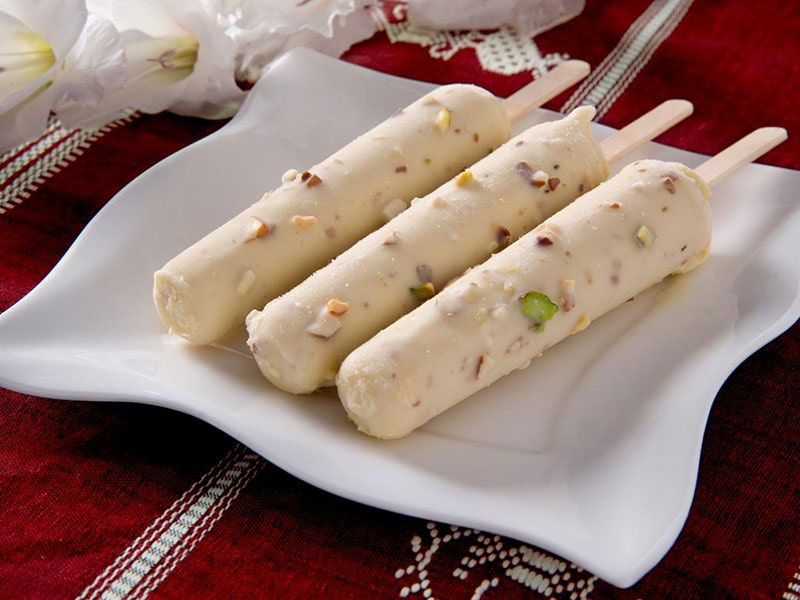
Hailing from the Indian subcontinent, Kulfi eventually arrived in Saudi Arabia and became a tempting treat few could resist.
It is rather similar to ice cream, using the same ingredients: cream milk, sugar, and flavorings. But Kulfi is much richer and denser than what you can find at your local grocery store.
In addition, this frozen dairy dessert comes in very exquisite flavors, like cardamom, rose water, saffron, and pistachio. I also love how it melts slower than ice cream, which is a blessing on hot summer days when all I want is a cool treat to last. Many Saudi Arabian street vendors offer this delight.
Mantu (Savory Dumplings)
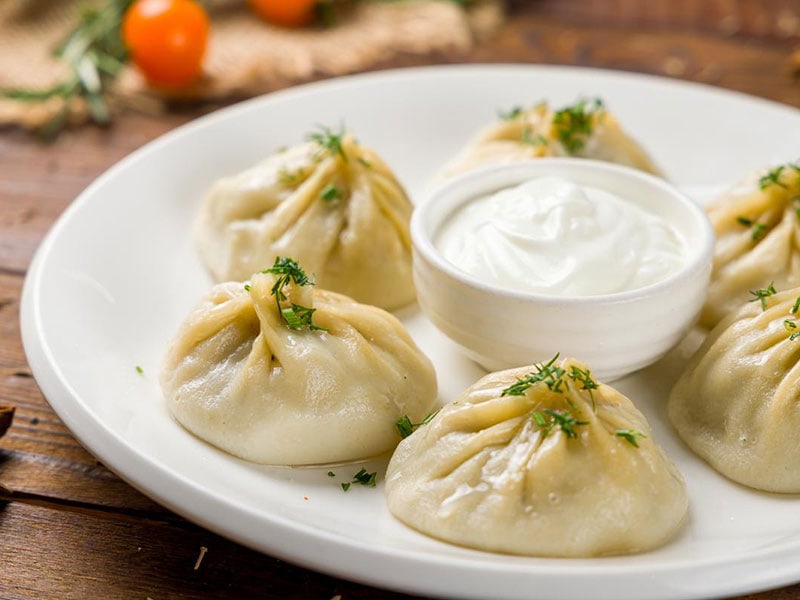
From their home in China, dumplings have traveled far and wide. Their Saudi Arabian version is called Mantu and contributes greatly to the street food scene of urban areas of Hejaz (western Saudi Arabia), like Jeddah and Mecca.
Similar to Manti in Turkey and Uzbekistan, Mandu in Korea, and Gyoza in Japan, Saudi Arabian Mantu is often an appetizer filled with a savory meat mixture and steamed until juicy. Each bite reveals a complexity of flavors that I love dearly.
Camel Burger
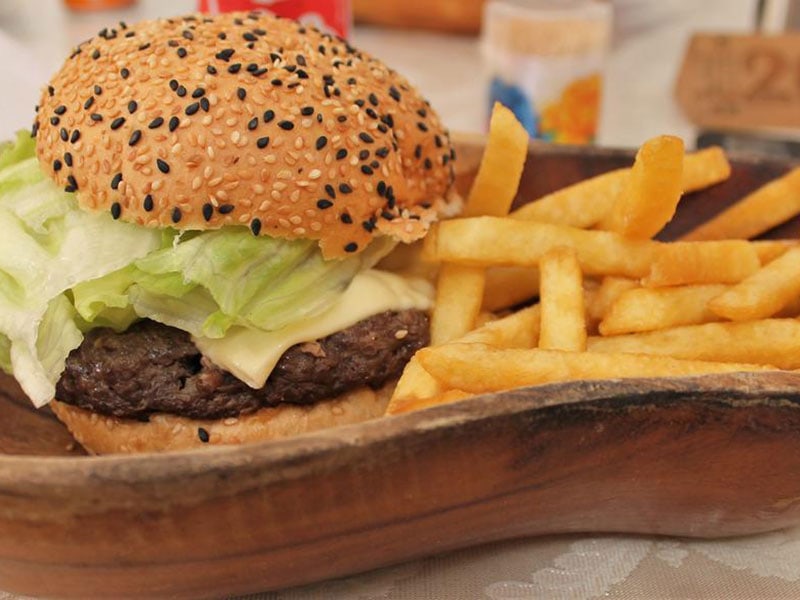
Have you ever tried a camel burger? In Saudi Arabia, it is a popular choice among other mainstream meat varieties, and the demand is still increasing [2]. After having a taste of the meat, I stopped wondering why.
A camel burger isn’t your typical fast food. It is very lean and has a rich flavor with a distinct gaminess. Plus, it is a healthier alternative to the regular beef burger, thanks to its lower fat content.
Yughmish / Yugmish (Leavened Bread With Meat)
If you’re looking for a quick snack, let me guide you toward Yughmish. It is a simple combination of leavened bread stuffed with juicy minced meat. You can find it at many street food stalls and restaurants. The snack is simple yet carries a robust flavor punch.
Koozi (Meat Over Rice And Noodles)
Koozi is a nutritious main course made of meat, rice, noodles, eggs, and spices. Whether it’s lamb, beef, or chicken, this dish always brings comfort to my palate and stomach. Both fancy restaurants and street vendors offer high-quality Koozi, so just choose what suits your preferences.
Each bite is like a celebration of rich, warm flavors, perfect for a fulfilling lunch or dinner. Interestingly, Iraqi people call it Quzi and even consider it one of the most important dishes in their cuisine.
Other Cuisines
Al-Machboos (Mixed Rice Dish) – Dubai
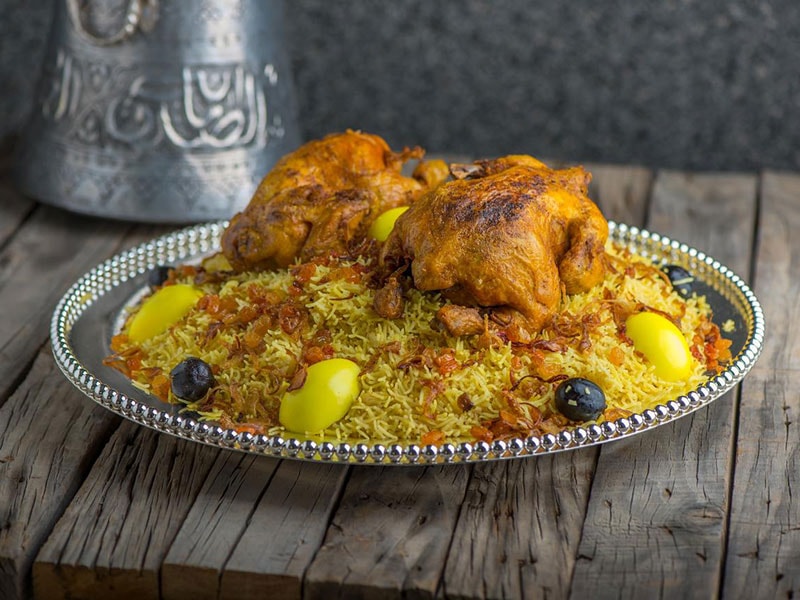
Al-Machboos is a riveting rice dish in Emirati cuisine. It is a dazzling display of fragrant basmati rice cooked with tender chicken, aromatic spices, and a rich sauce. While chicken is a common choice, you can also opt for lamb, fish, or shrimp as the meat component.
The dish is beautifully presented with a large piece of meat placed atop the bed of rice along with nuts. Al-Machboos is particularly cherished during the holy month of Ramadan.
Those seeking an authentic street food experience in Dubai can head to places like Meena Bazaar, Ripe Market, or the street food trucks along the famous Sheikh Zayed Road.
Mansaf (Lamb Cooked In Yogurt-based Sauce) – Jordan
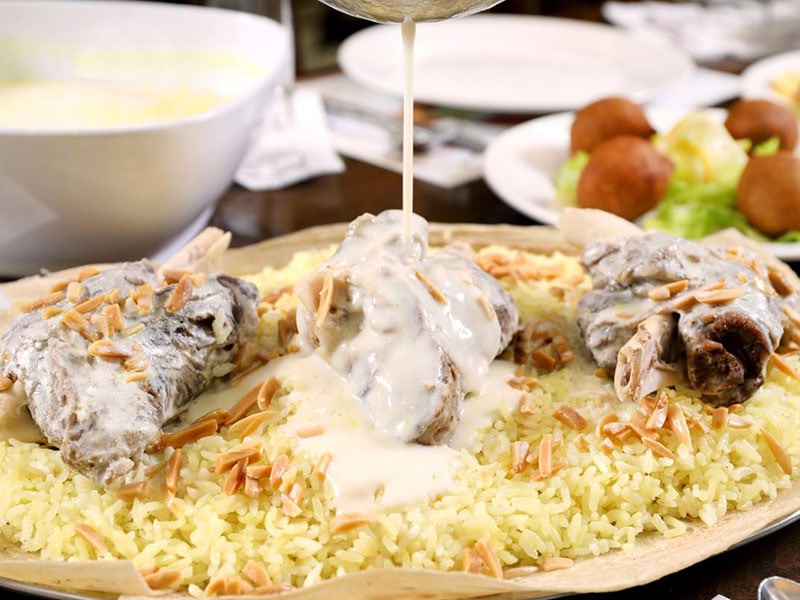
While Mansaf is the national dish of Jordan, it is also a gem in Syrian, Kuwaiti, and Saudi Arabian cuisines. This iconic dish showcases tender lamb slow-cooked in a yogurt-based sauce called jameed. The meat is simmered for hours to achieve a succulent finish.
The traditional way of serving Mansaf involves a large communal plate with rice or bulgur. In Jordan, locals enhance the dish by pouring steaming goat’s milk over it. They enjoy the dish by rolling the rice, meat, and other ingredients into a ball with their right hand.
Quwarmah Al Dajaj (Curried Chicken) – Kuwait
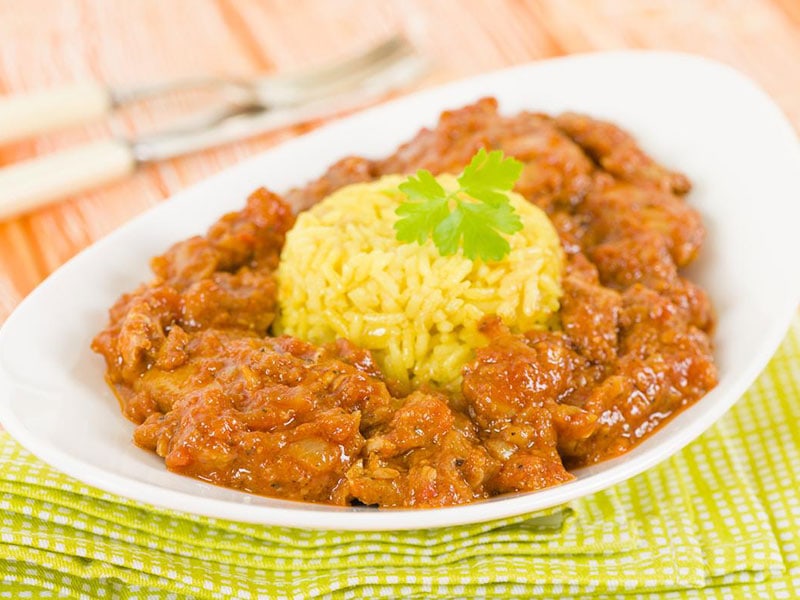
Quwarmah Al Dajaj is a prominent dish in the Arabian Gulf. It consists of succulent chicken flavored with multiple spices, like paprika, salt, nutmeg, cardamom, cumin, and more. The curry is excellent at accompanying aromatic saffron rice and salads.
Mutabbaq Samak (Rice With Fried Fish) – Kuwait
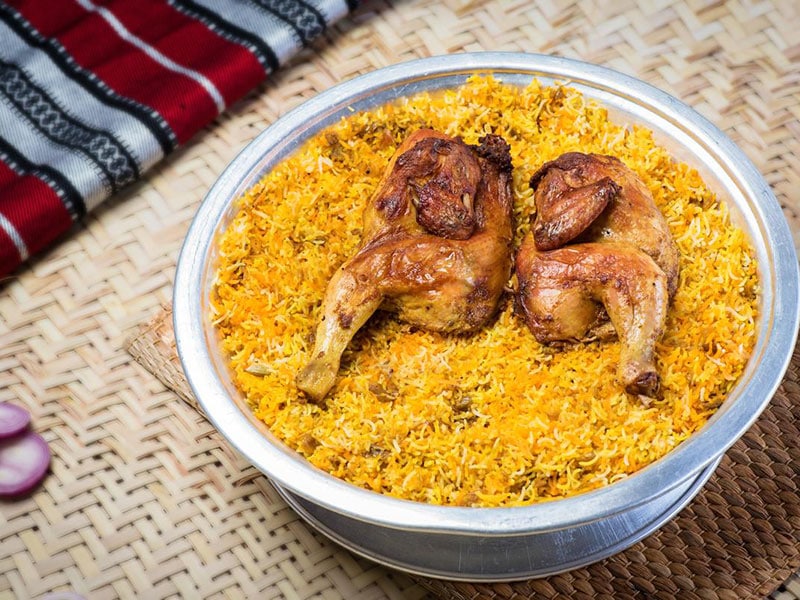
Mutabbaq Samak is a cherished rice-based delicacy in Kuwait and various Arab countries. Each region has its own unique recipe, but the dish typically involves cooking rice with spiced fish stock.
So basically, this specialty is all about spiced fried fish and fragrant fried onions served atop a bed of fluffy rice. Pomfret is a popular type of fish for Mutabbaq Samak.
The Role of Street Foods in Middle Eastern Society and Culture
Street Foods And Socialization
Street food in the Middle East is an integral part of the social fabric. Marketplaces (known as souks) are bustling centers of daily life where people come not only to shop but to socialize. Sharing food in these settings is a deeply rooted tradition.
Friends gather around a shawarma stand, families share a communal plate of hummus, and businessmen haggle over prices with a falafel sandwich in hand. This shared culinary experience often acts as a social equalizer that unites people from diverse socioeconomic backgrounds.
Street Foods And Festivals/Celebrations
During Ramadan, the streets come alive each night with vendors selling special foods like dates, lentil soup, and sweet pastries for the breaking of the fast.
Similarly, sweet treats like baklava and Knafeh are ubiquitous during Eid celebrations. The sharing of these foods not only nourishes the body but also strengthens community ties and cultural identity.
Street Food Vendors and Markets
Role Of Street Food Vendors
Street food vendors are the heart and soul of the Middle Eastern street food scene. They are often individuals or families who have perfected their recipes over generations.
These vendors provide the local community with affordable, nutritious meals and often chances for conversation. For tourists, they offer an authentic taste of local culture and tradition.
Famous Street Food Markets In The Middle East
The Middle East is home to some of the world’s oldest and most fascinating food markets. Jerusalem’s Mahane Yehuda Market, Istanbul’s Grand Bazaar, and Marrakech’s Jemaa el-Fnaa are just a few examples. Each market offers a unique set of flavors and dishes.
The Influence And Spread of Middle Eastern Street Foods Globally
Middle Eastern Street Foods In Western Countries
The popularity of Middle Eastern cuisine has surged in Western countries over recent decades. Culinary delights like hummus, falafel, and shawarma are now best-loved street food items in Europe, North America, Australia, and more.
This trend is due in part to the unique flavors and health benefits associated with Middle Eastern foods, as well as immigration influence and an increasing global interest in culinary diversity.
Adaptations And Fusion Dishes
As Middle Eastern cuisine has traveled, it has adapted to local tastes and created fascinating fusion dishes.
For example, in New York City, you might find a food truck selling shawarma tacos, while in London, a local café might serve a Middle Eastern-inspired full English breakfast with halloumi and tahini sauce.
FAQs
Deliciously Diverse: Middle Eastern Street Food Can Fit Every Palate
Each bite of Middle Eastern street foods is a testament to the region’s profound culinary history. Indulge, and let these mouth-watering delicacies narrate their own stories. Whether you do so at an expansive bazaar or a tiny roadside food stall, it is always a wonderful experience to be savored.
Did you enjoy the read? If so, light up the comment section with your thoughts. Which dish is your favorite? Do you know any favorable destinations to try it? Please let other readers and me know. And don’t forget to share this post with your friends!
References
- Shew, P. by A. (2017) If kibbeh is on your menu, consider cooking it, USDA.
- IndexBox (2020) Camel Meat Market in the Middle East is driven by rising demand in Saudi Arabia, Global Trade Magazine.

